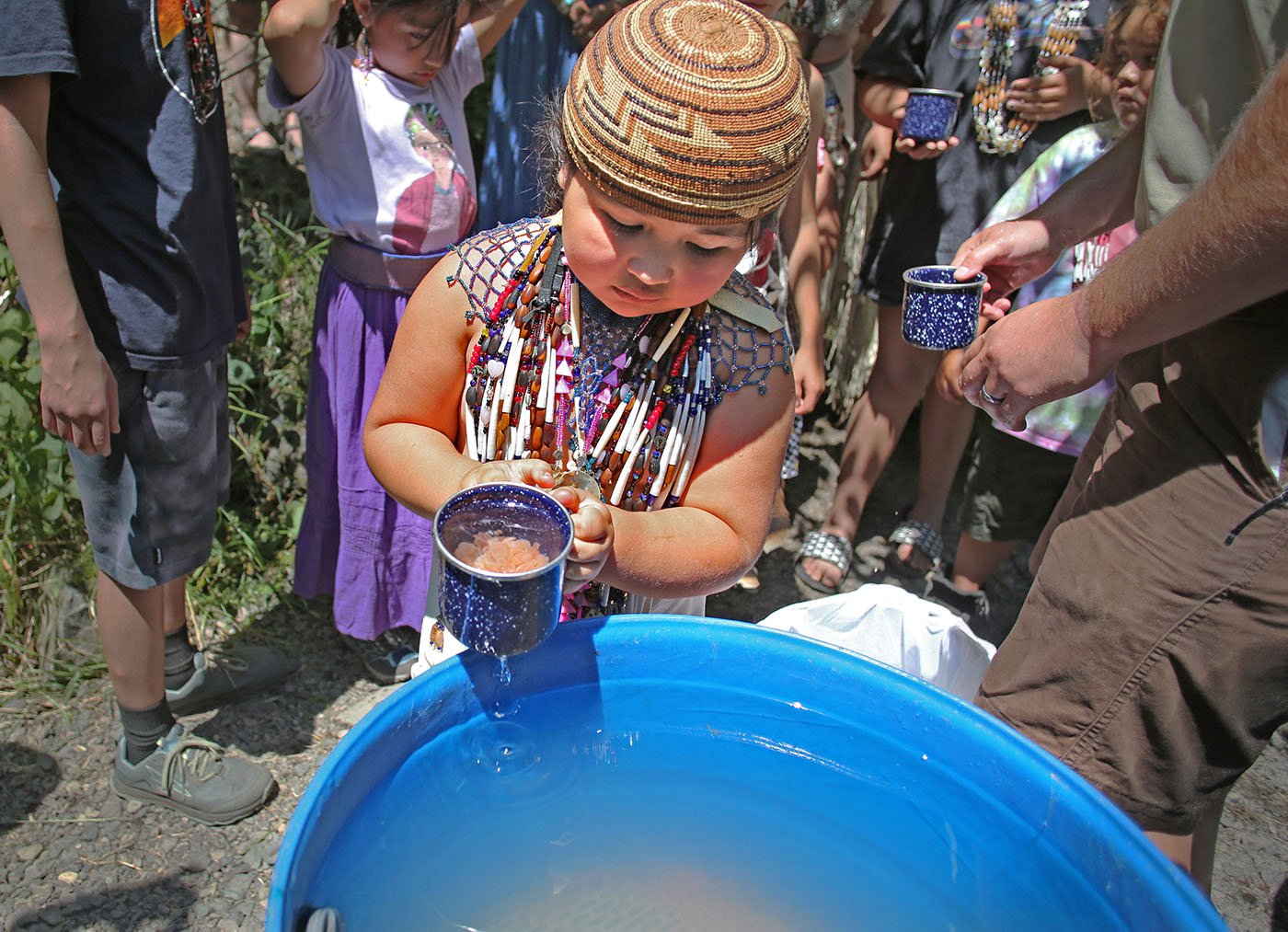Chapter 11. The Return of Salmon
“This is something that can actually happen. And those salmon already know it. I feel like they’re helping to explain this to the fish experts who think, well, they haven’t been there for 30 years, they’re not coming back. if we put those songs and prayers on the water. If we take that all the way to the ocean and we sing to the ocean and we dance to the ocean, they respond.”
— Chief Caleen Sisk, Hereditary and Spiritual Leader of the Winnemem Wintu people
Listen and subscribe to The Spiritual Edge wherever you listen to podcasts - Apple Podcasts, Spotify, Google Podcasts.
By Judy Silber
Winnemem Wintu Chief Caleen Sisk and I stand off to the side of a bridge, not too far from Shasta Reservoir and where she and other Winnemem Wintu live.
CHIEF CALEEN SISK: We’re on Dry Creek Road at one of the second bridges. We’re about 3 miles from the village.
In the summer, the bridge passes over a very dry creek bed. But it’s December now and water a few feet deep rushes past. A few months ago, just as heavy rains started up, she was here with her granddaughter.
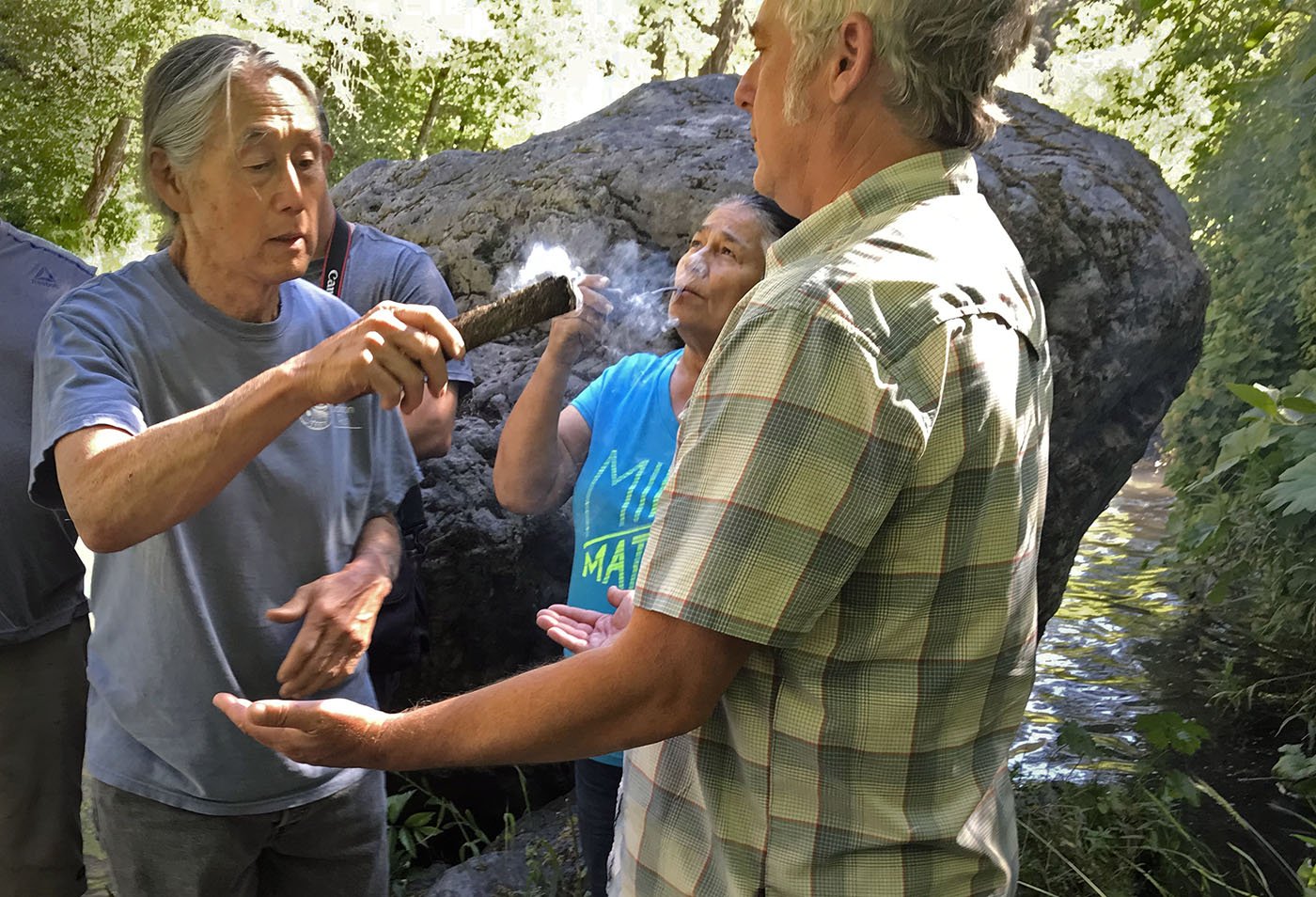
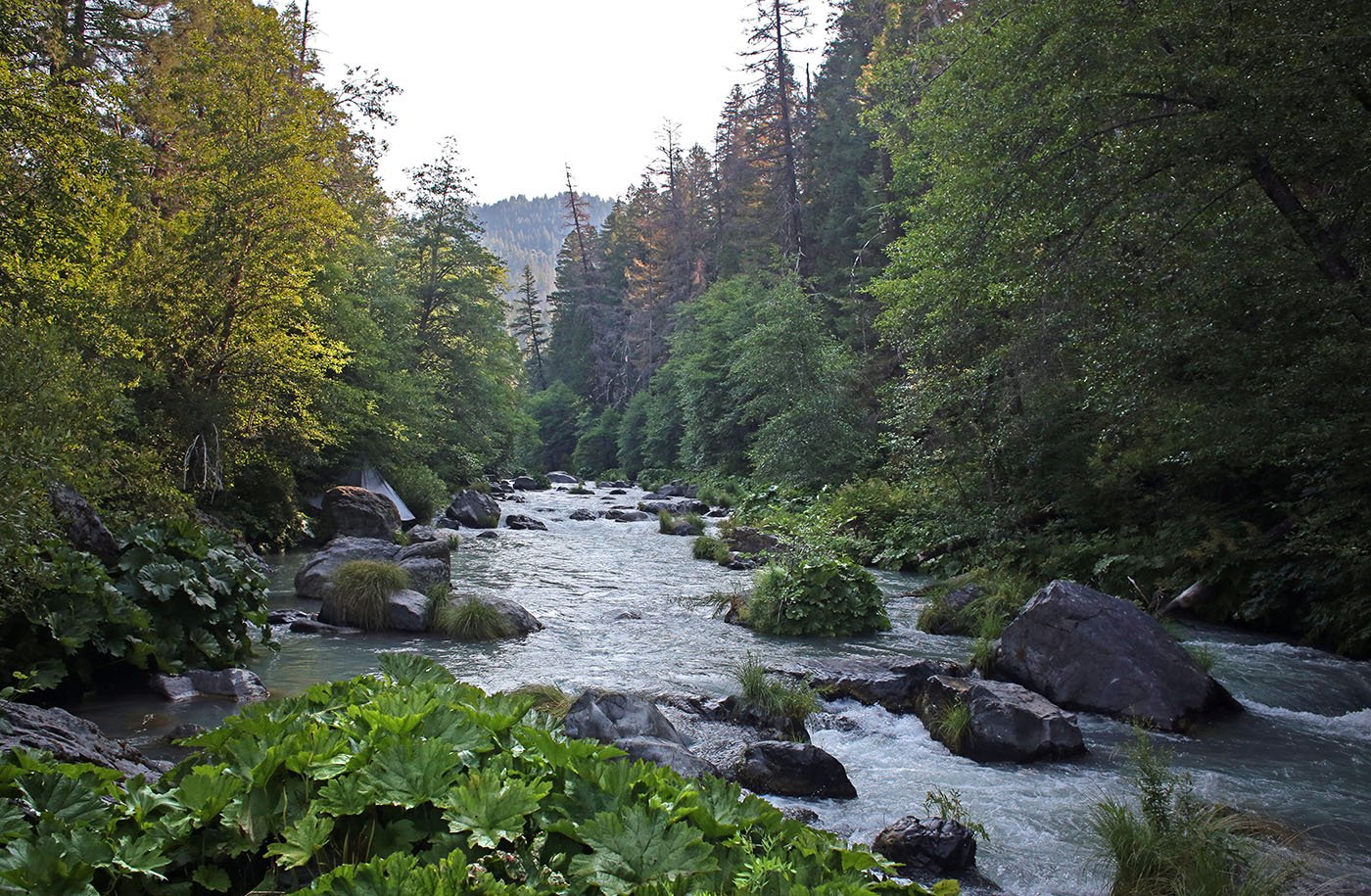
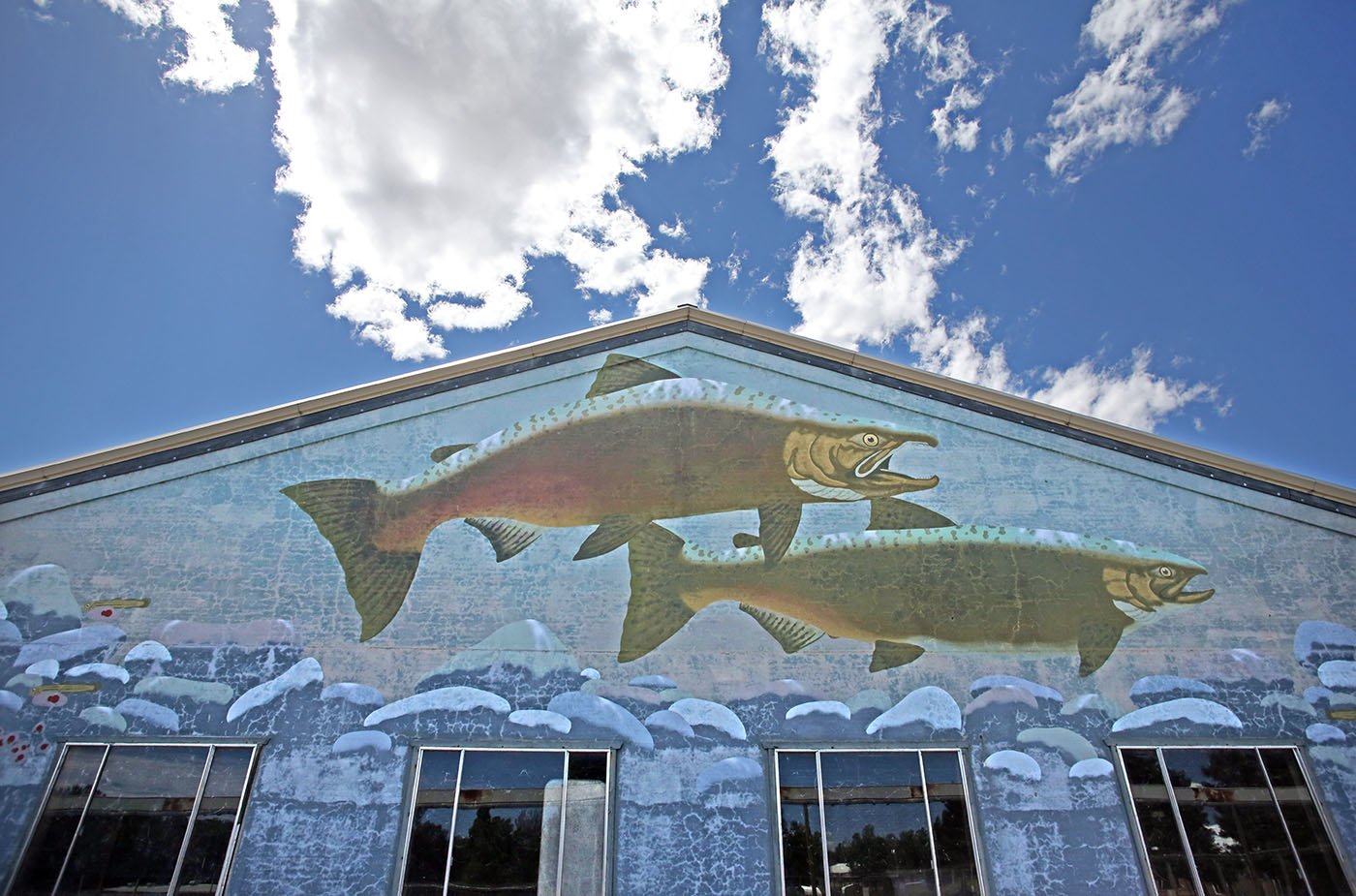
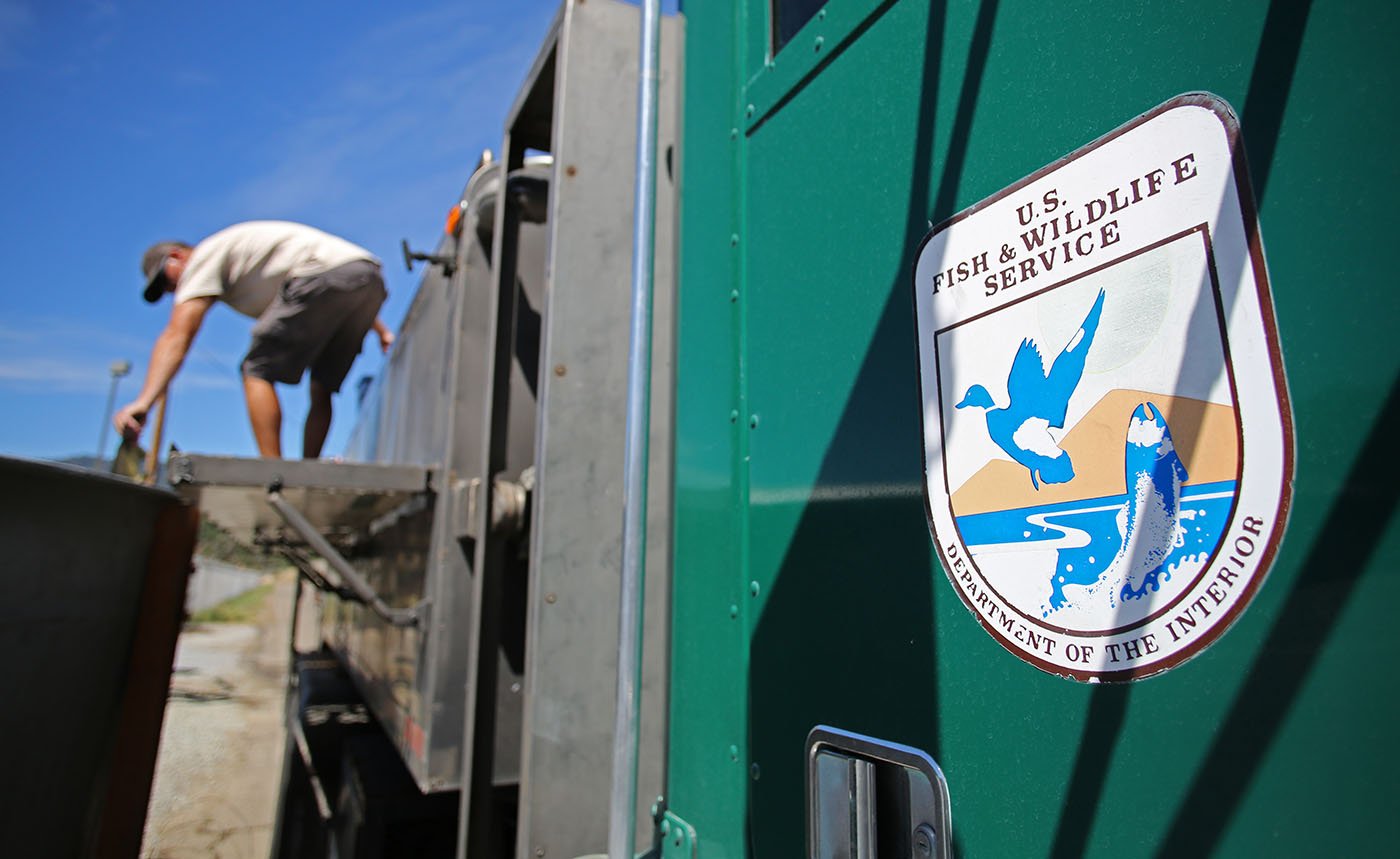
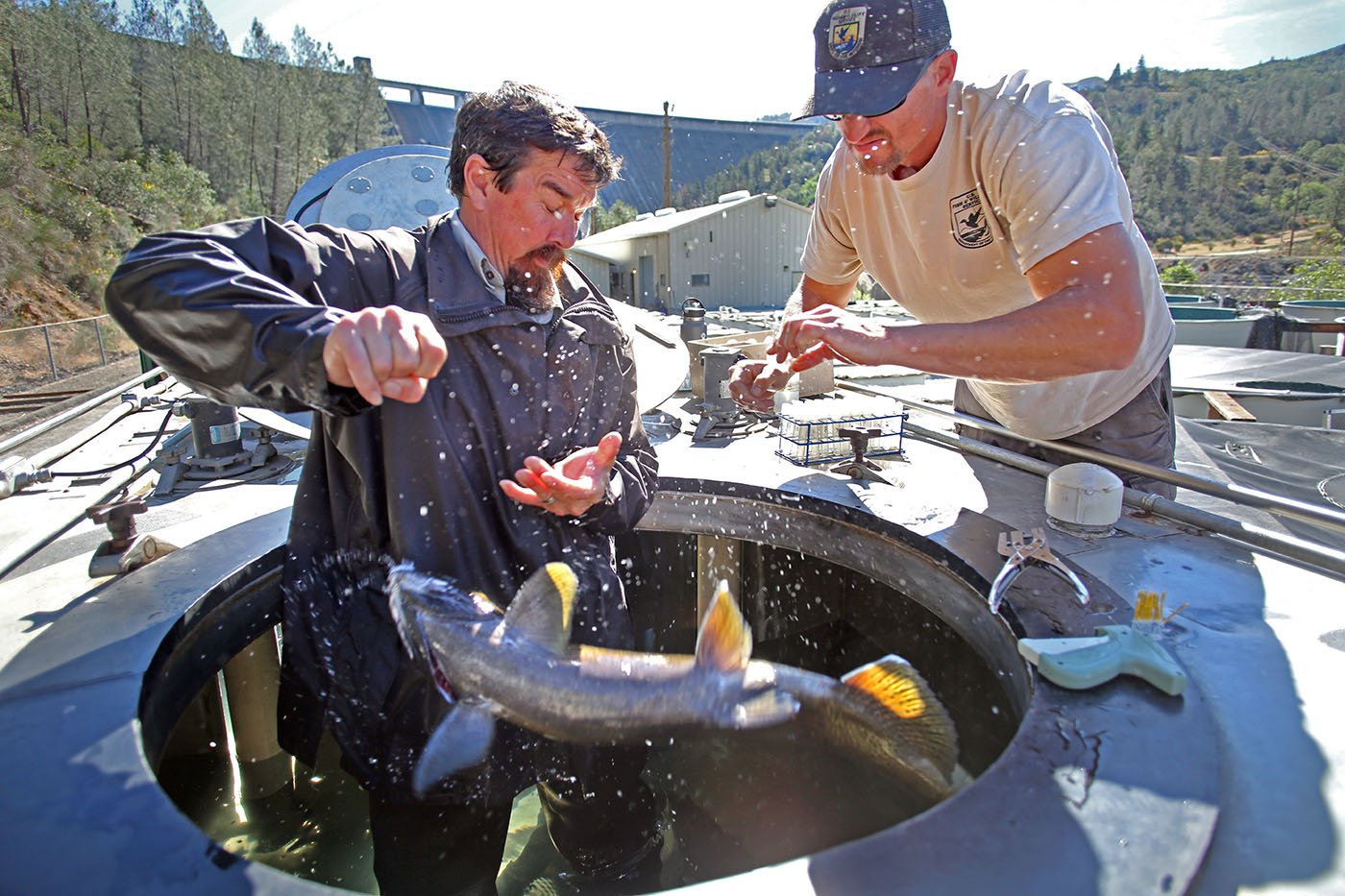
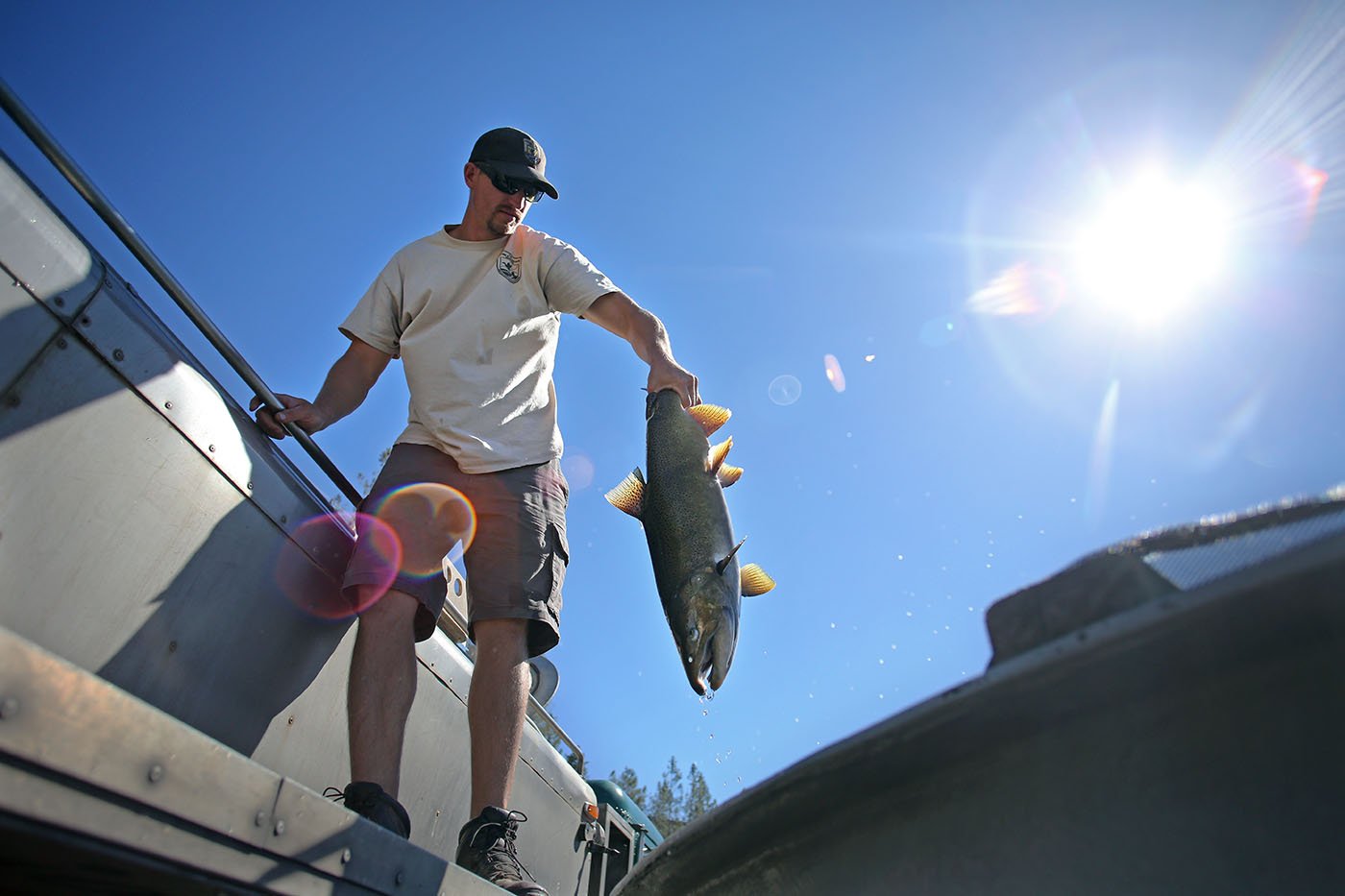
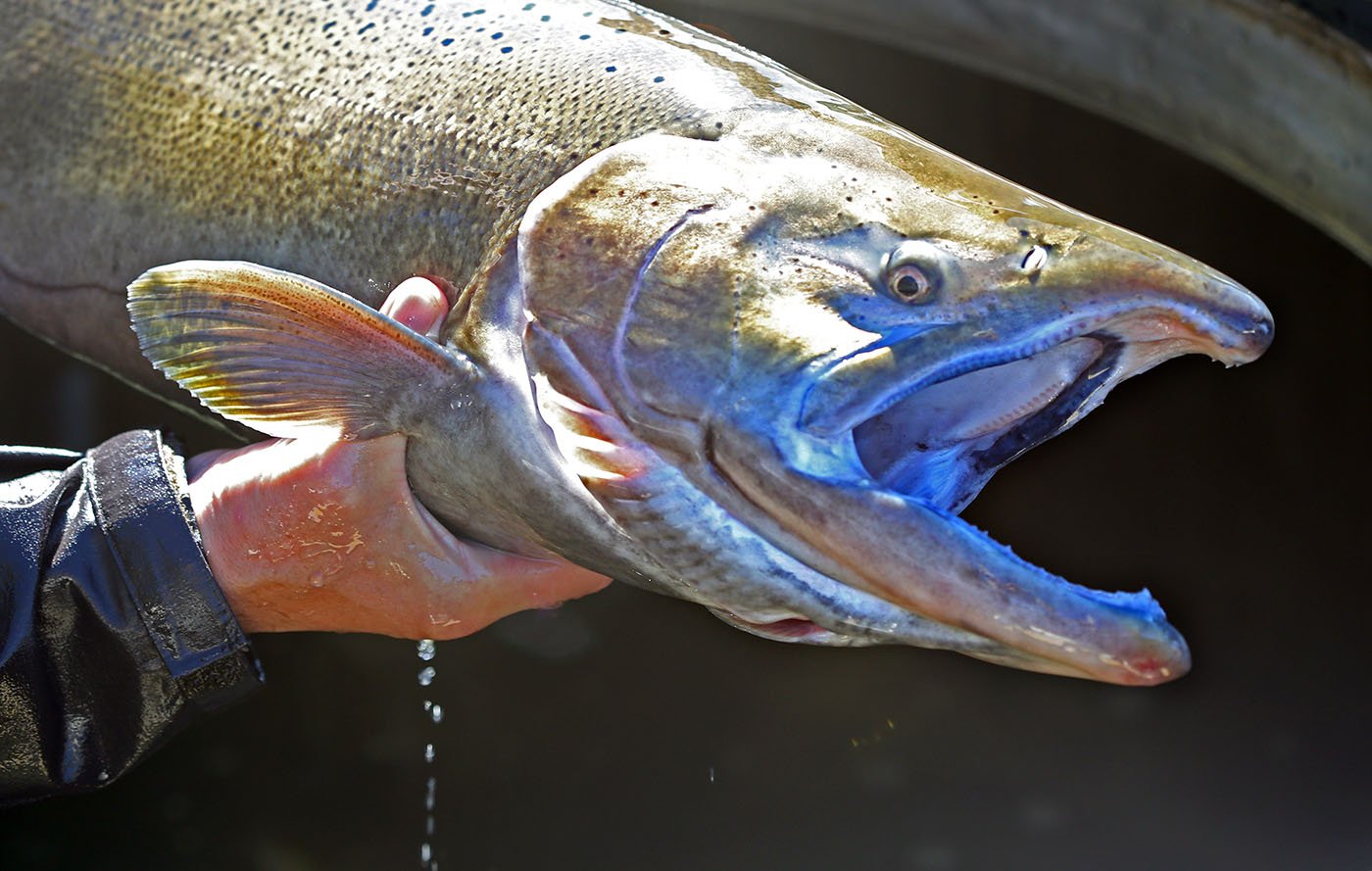
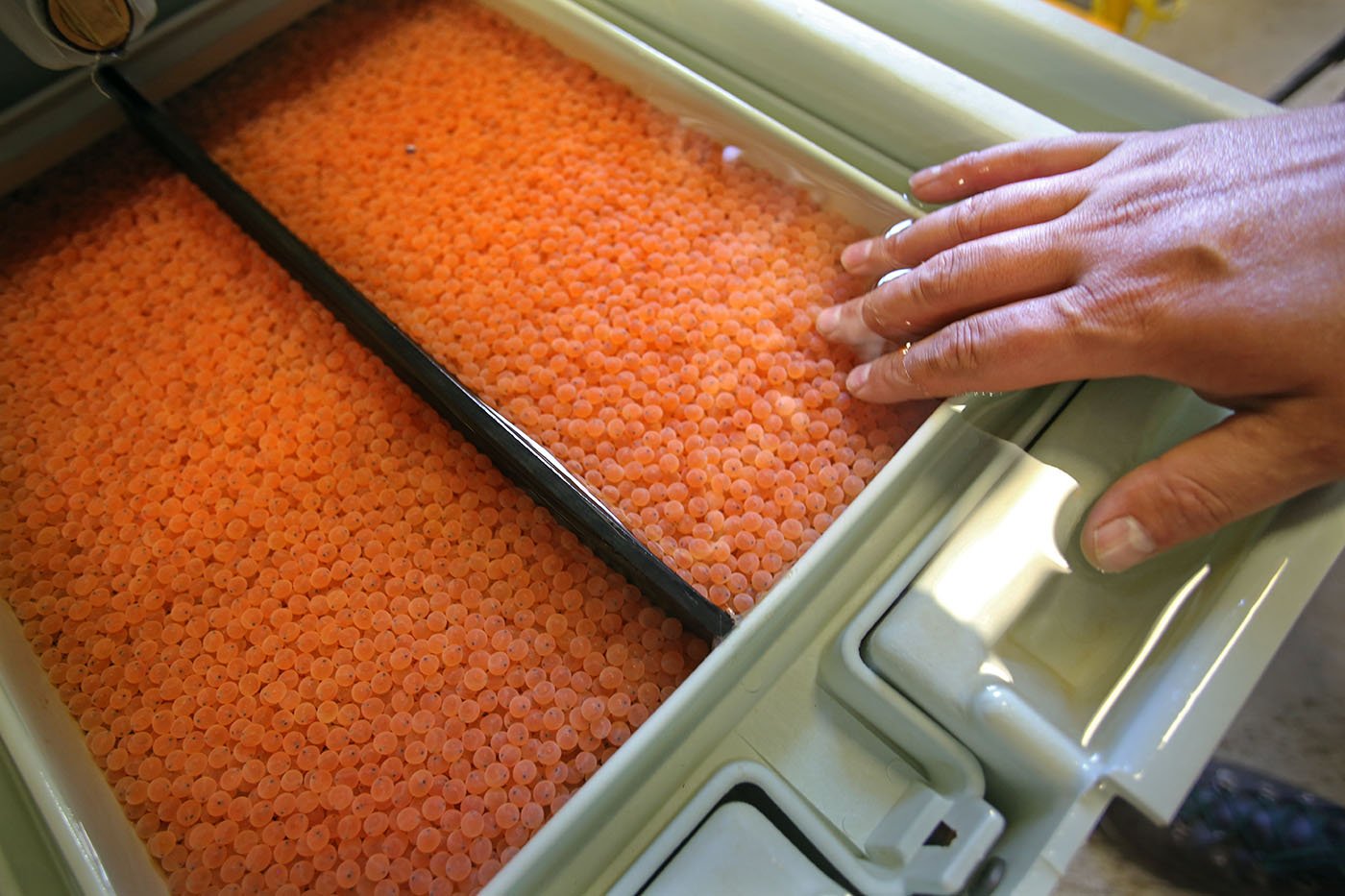

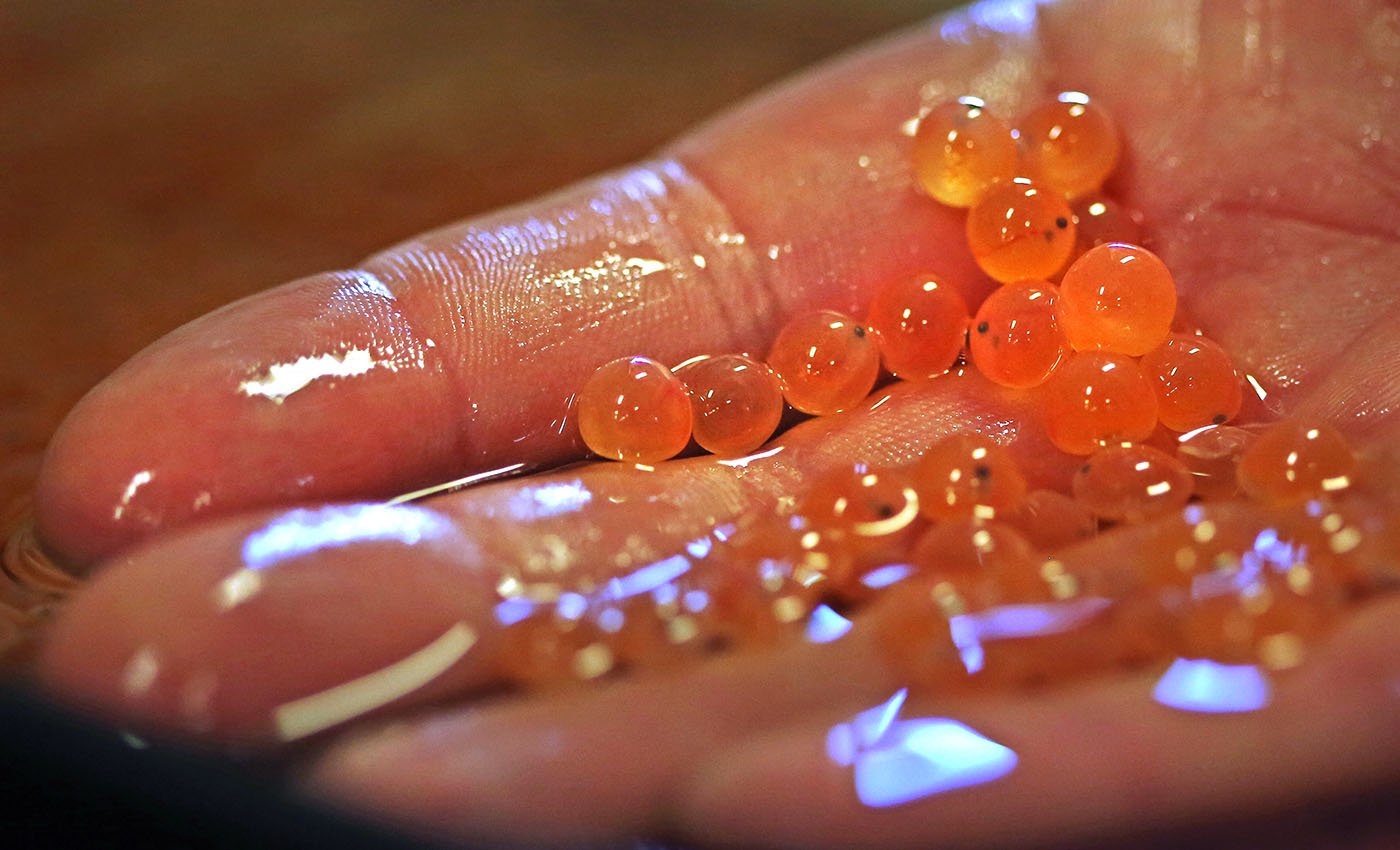
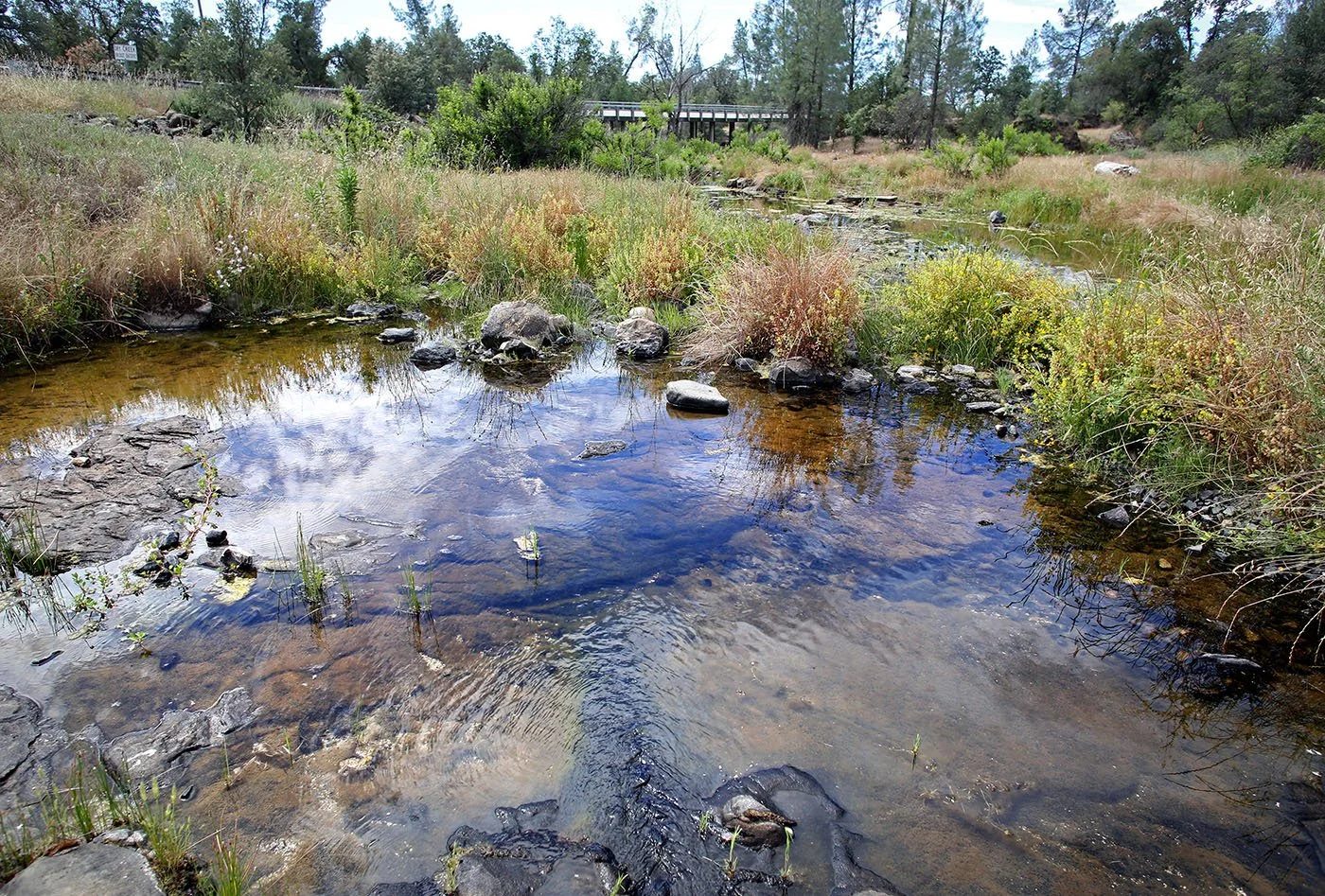
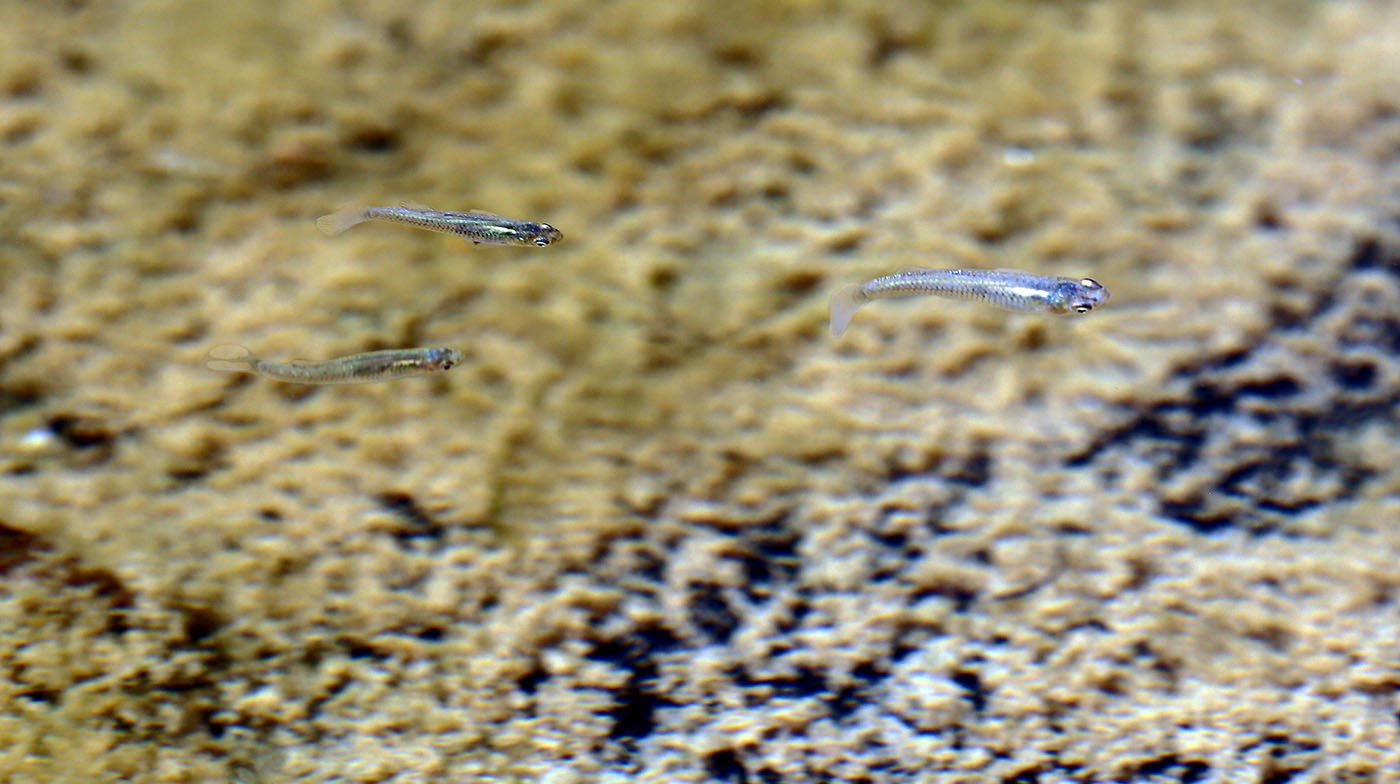
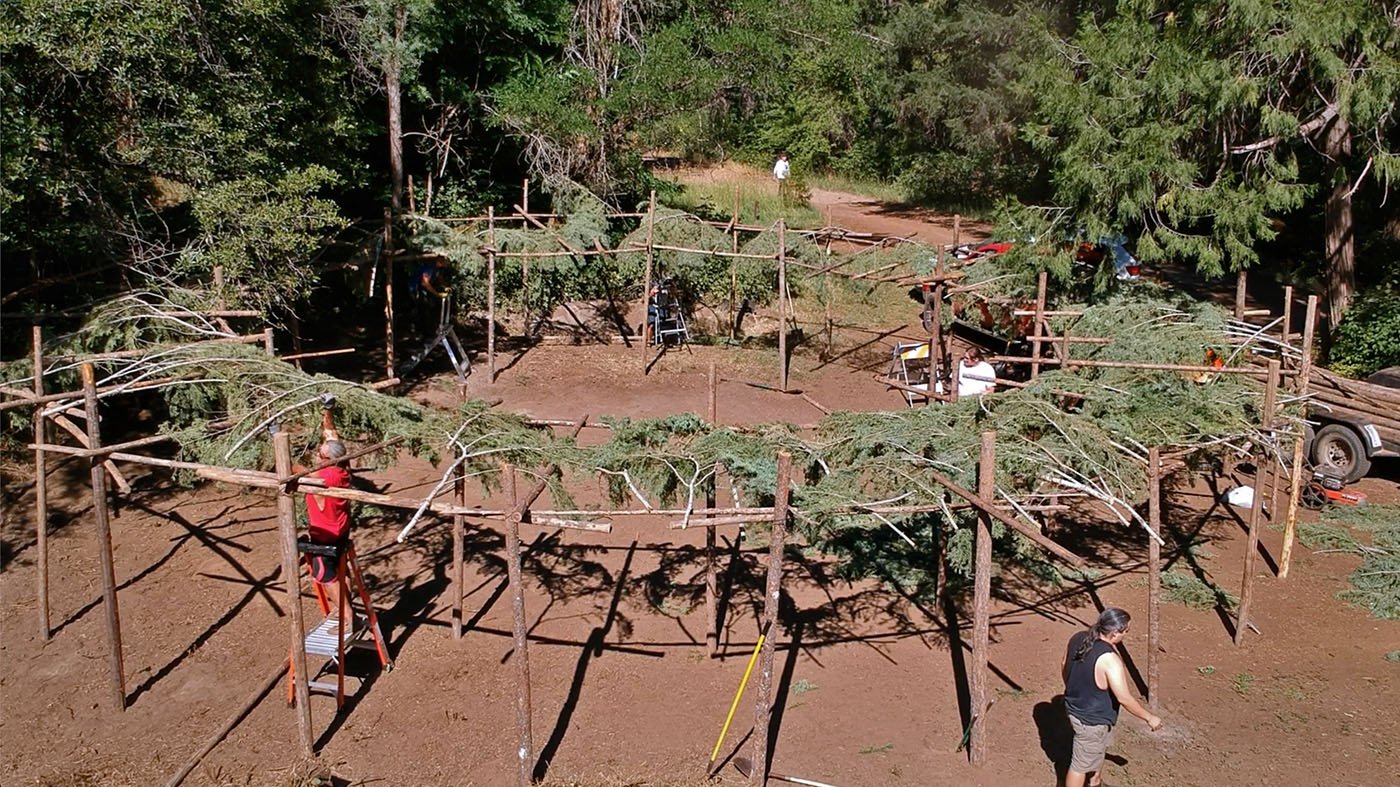
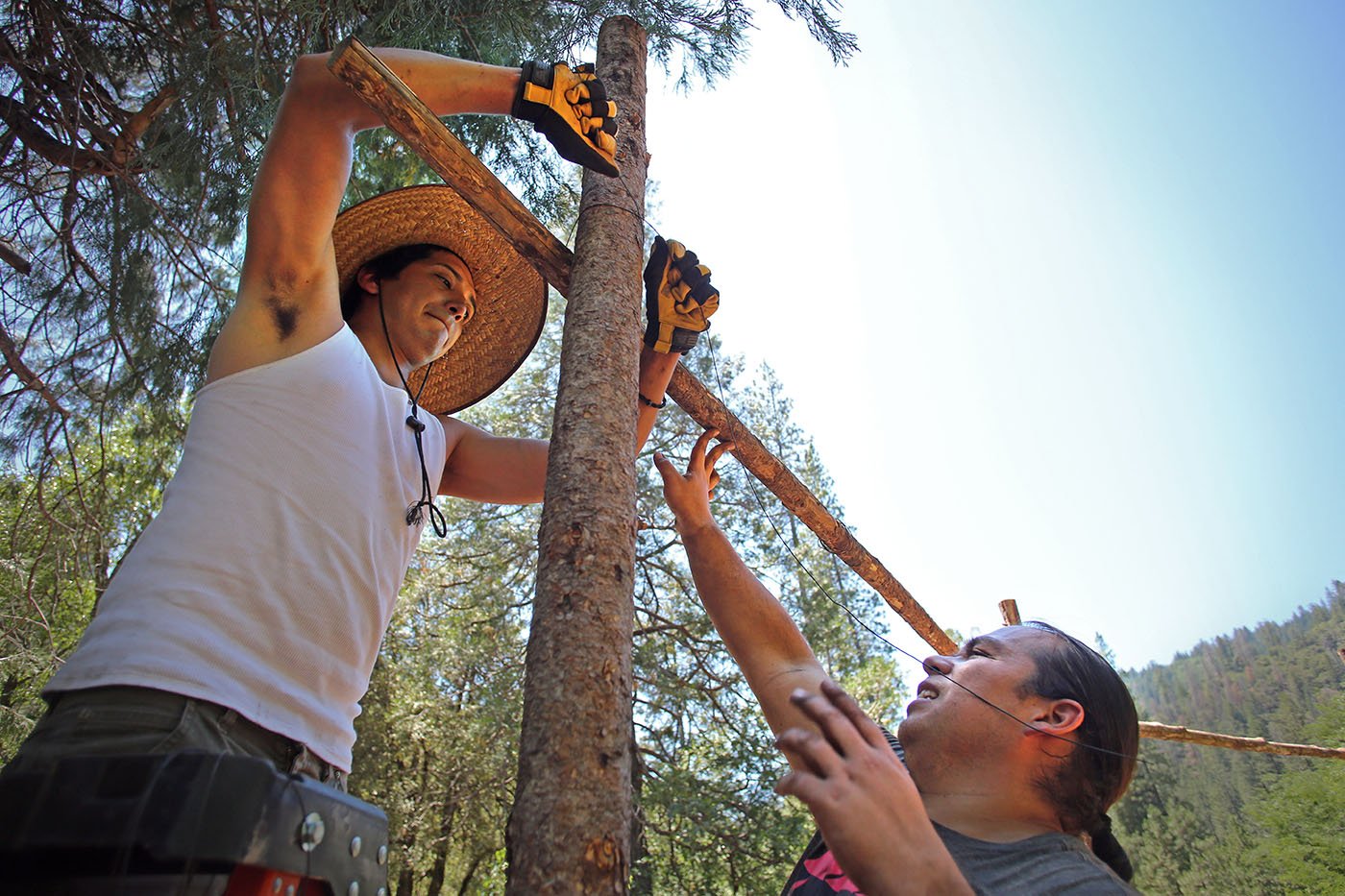
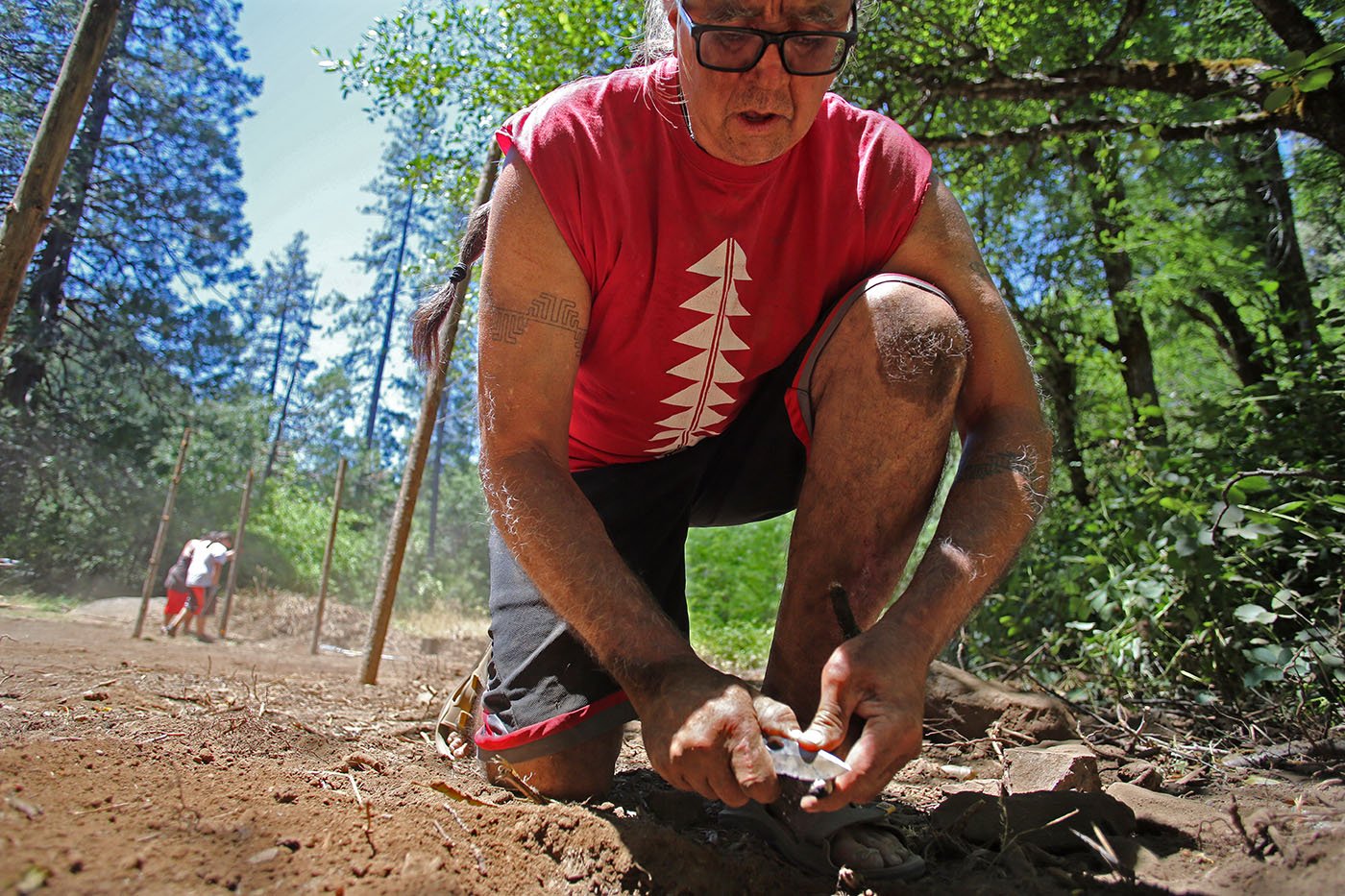
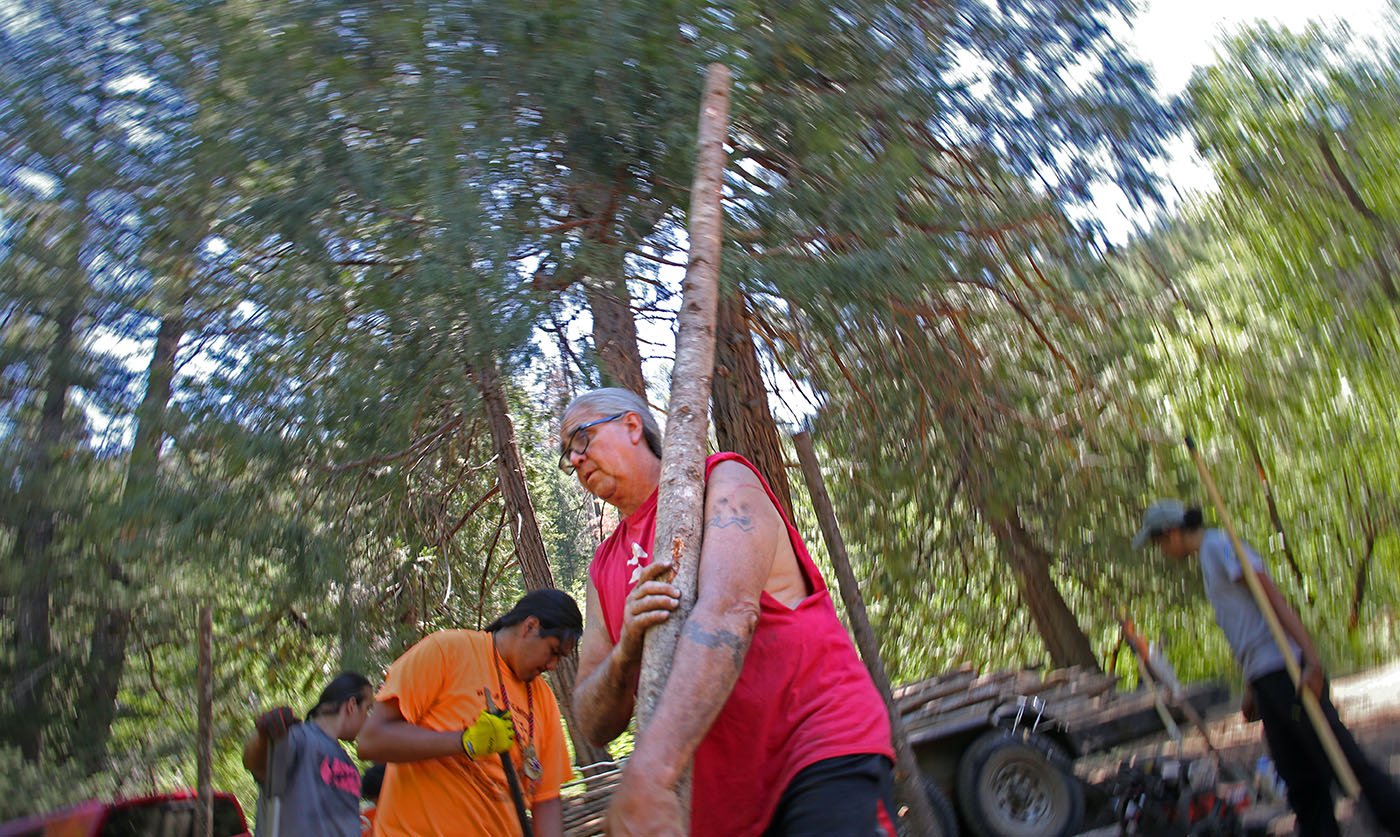
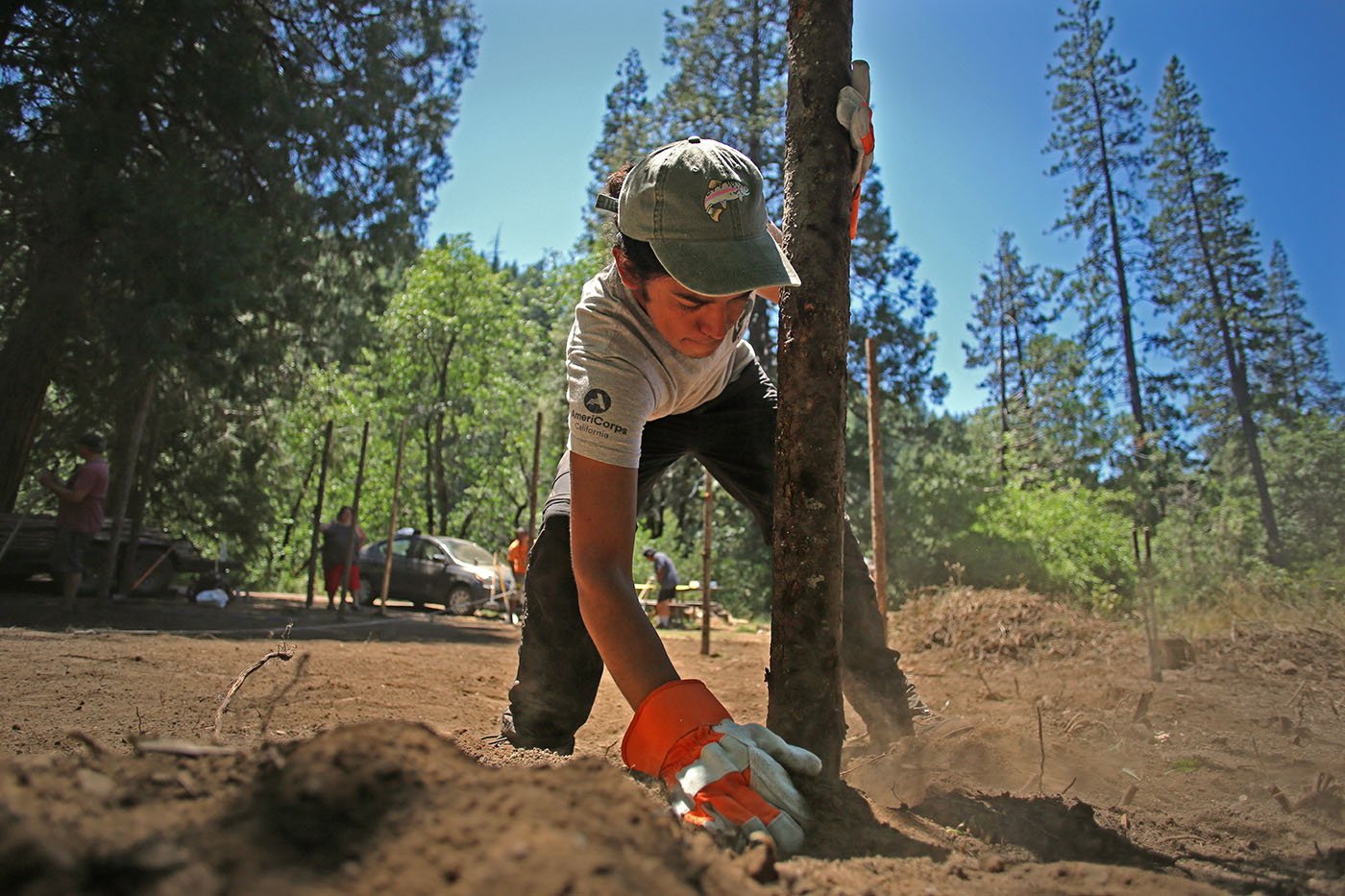

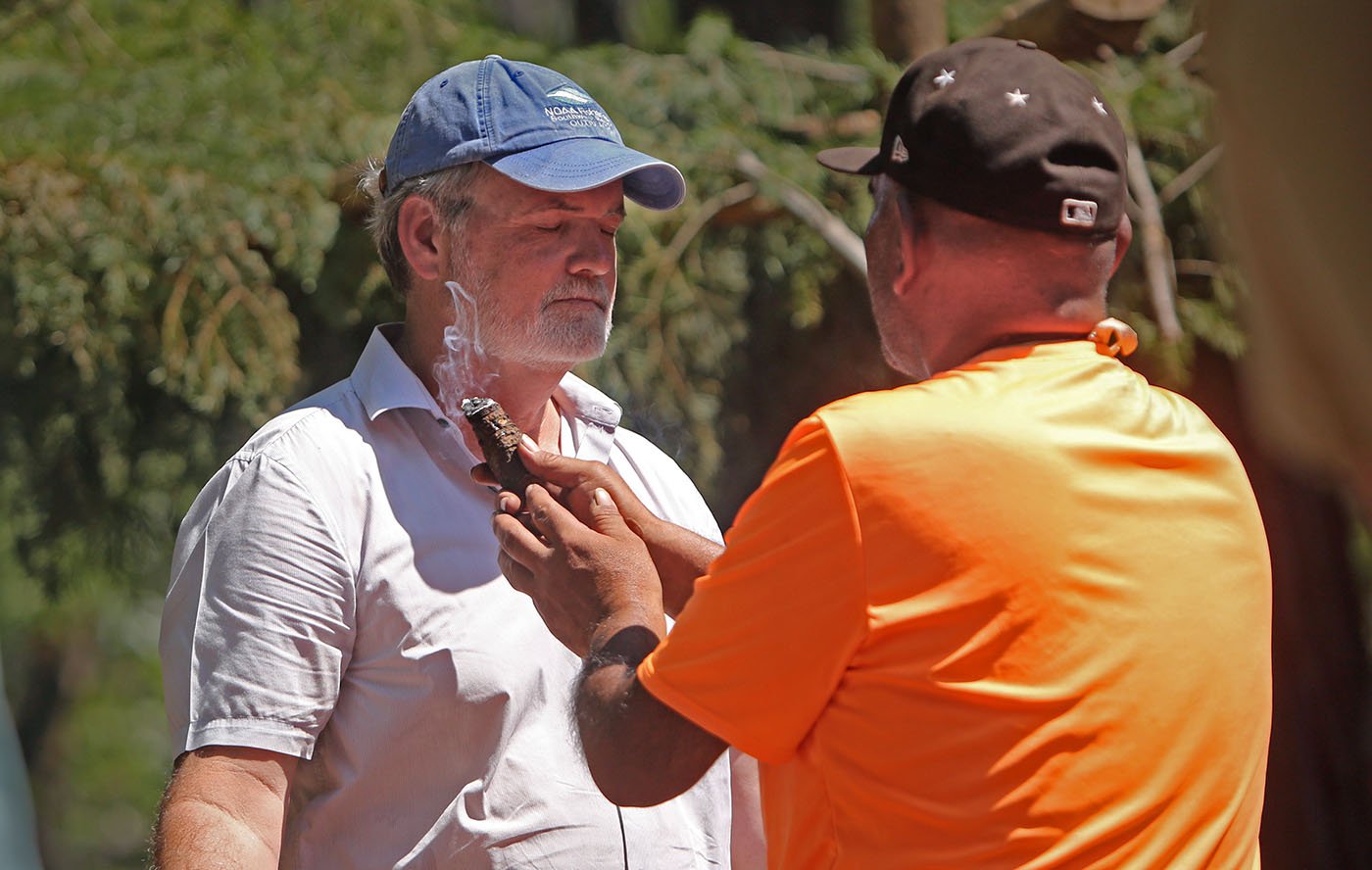
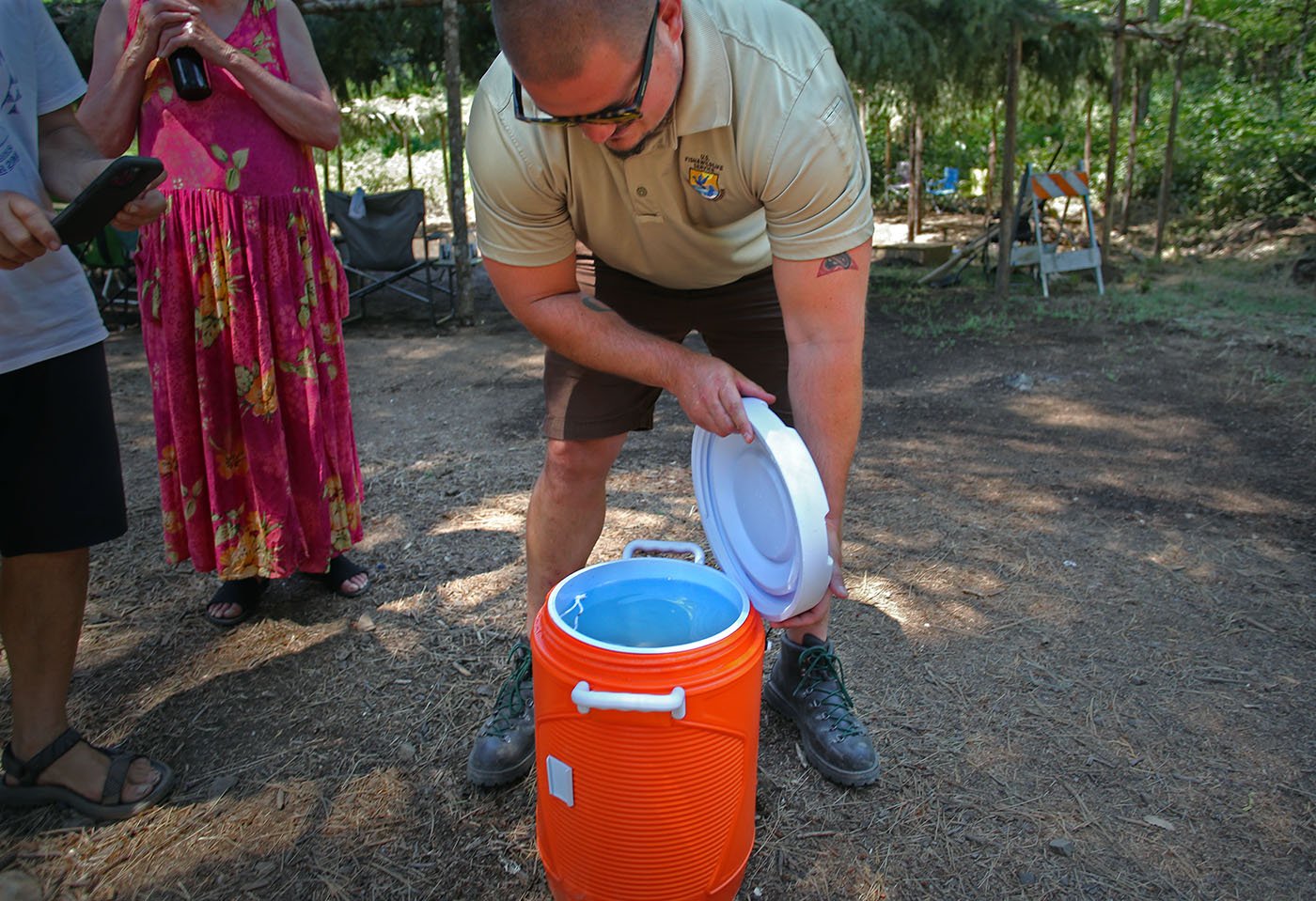
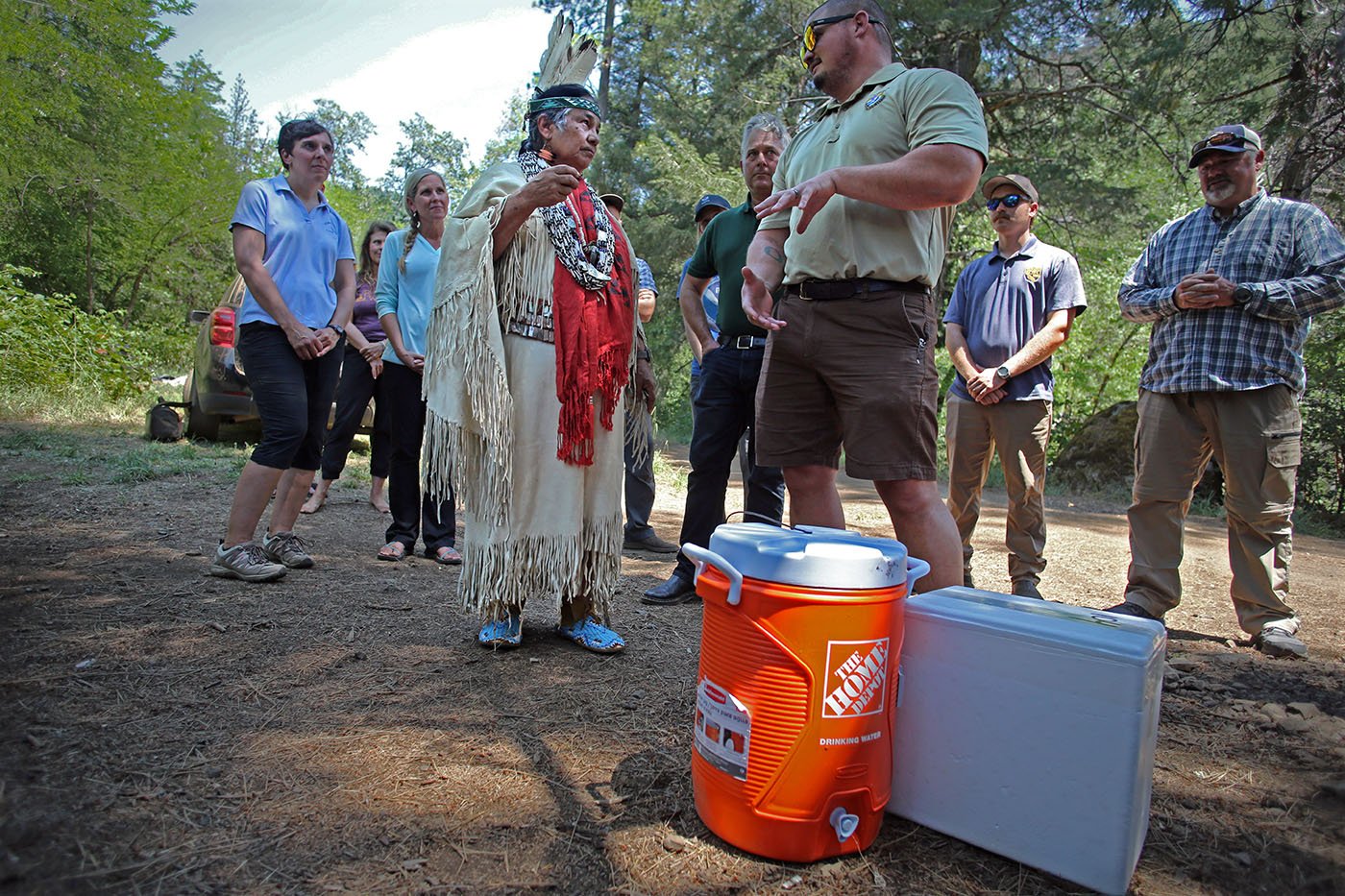
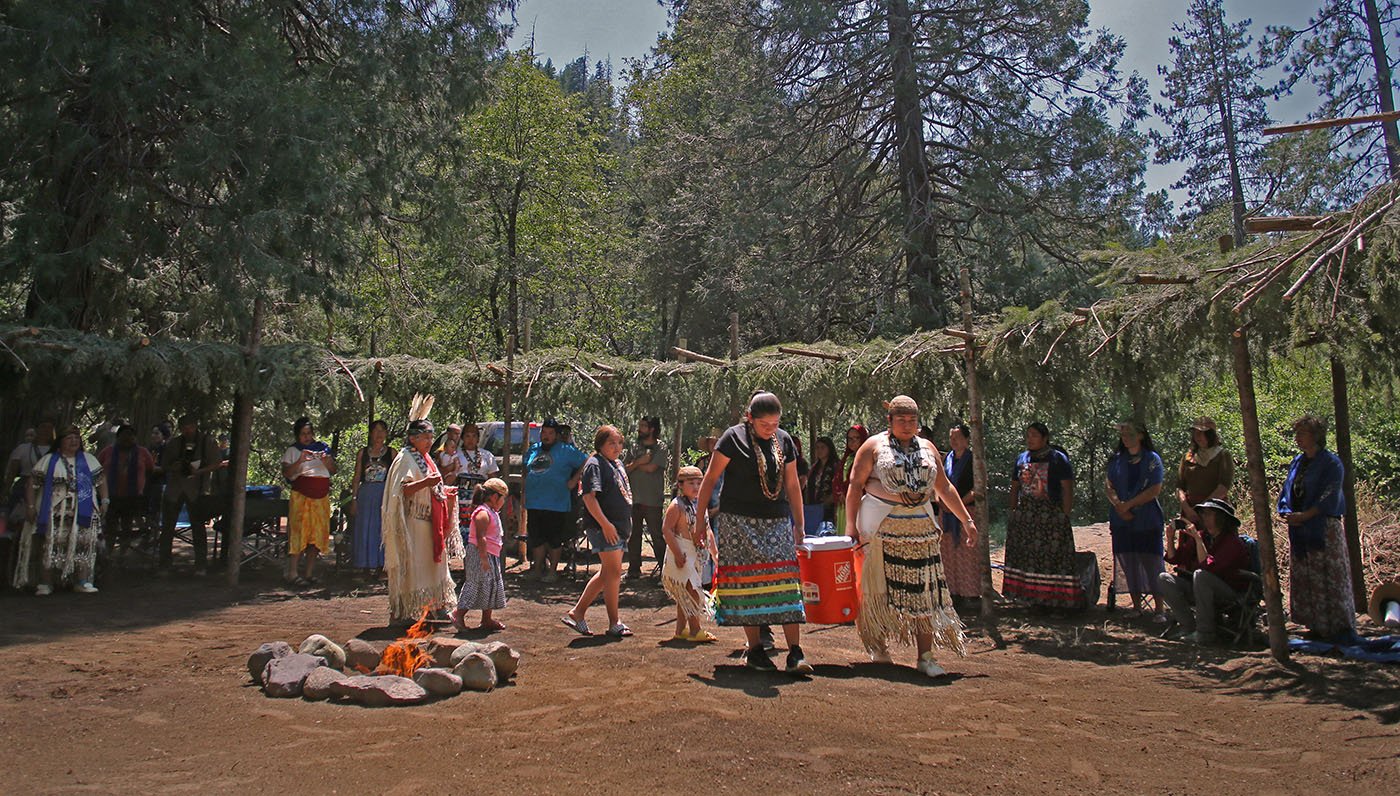
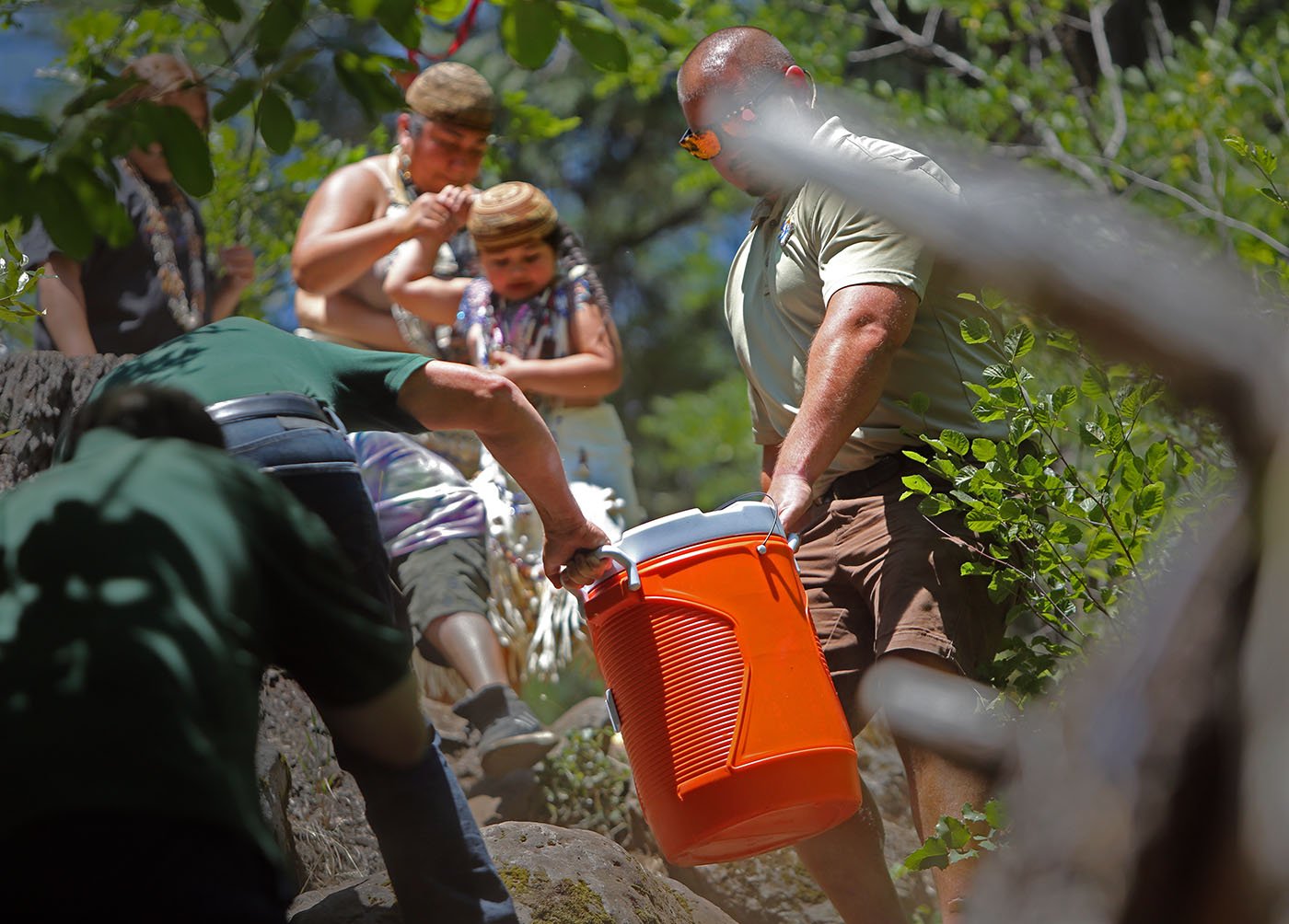
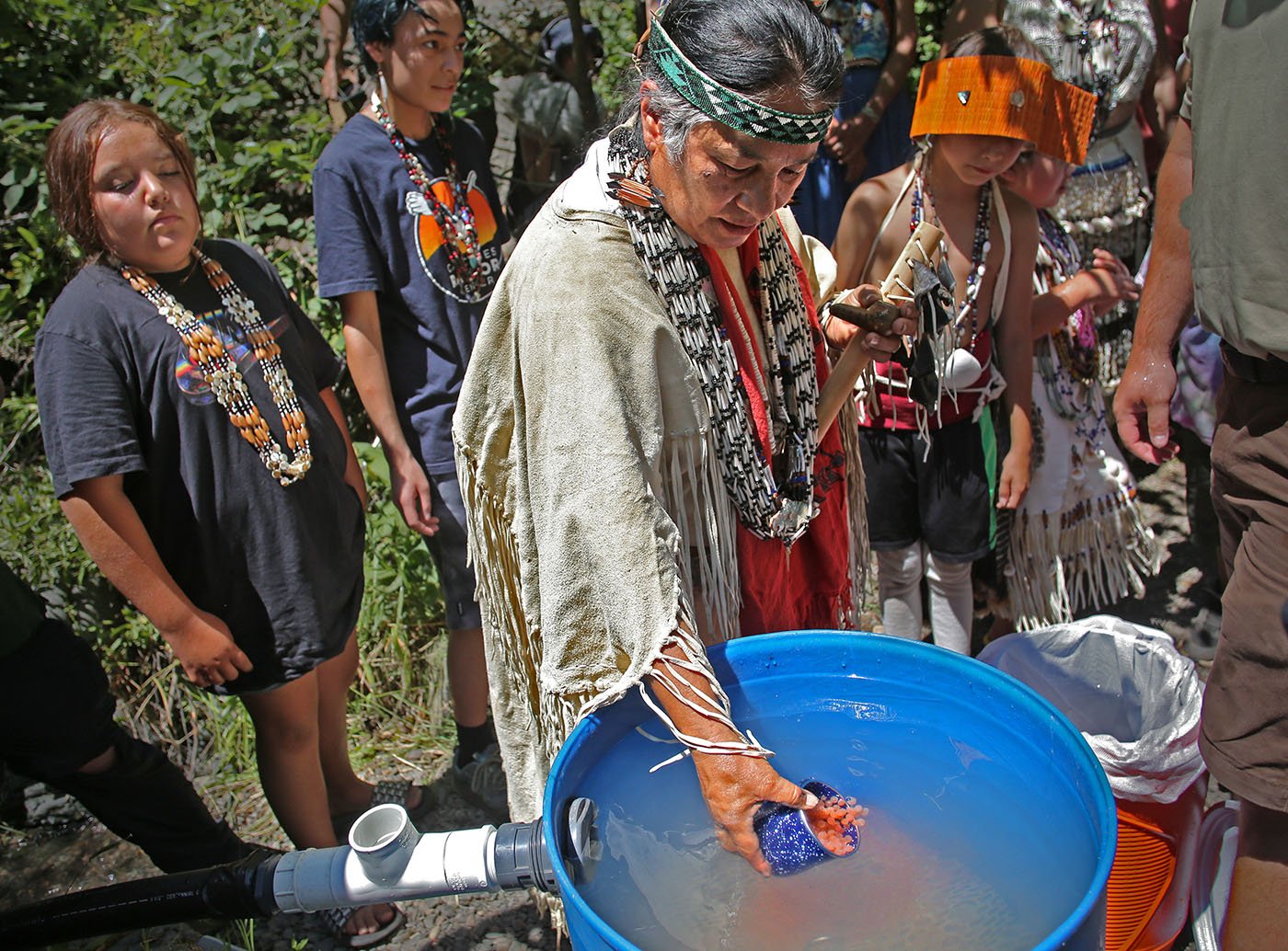
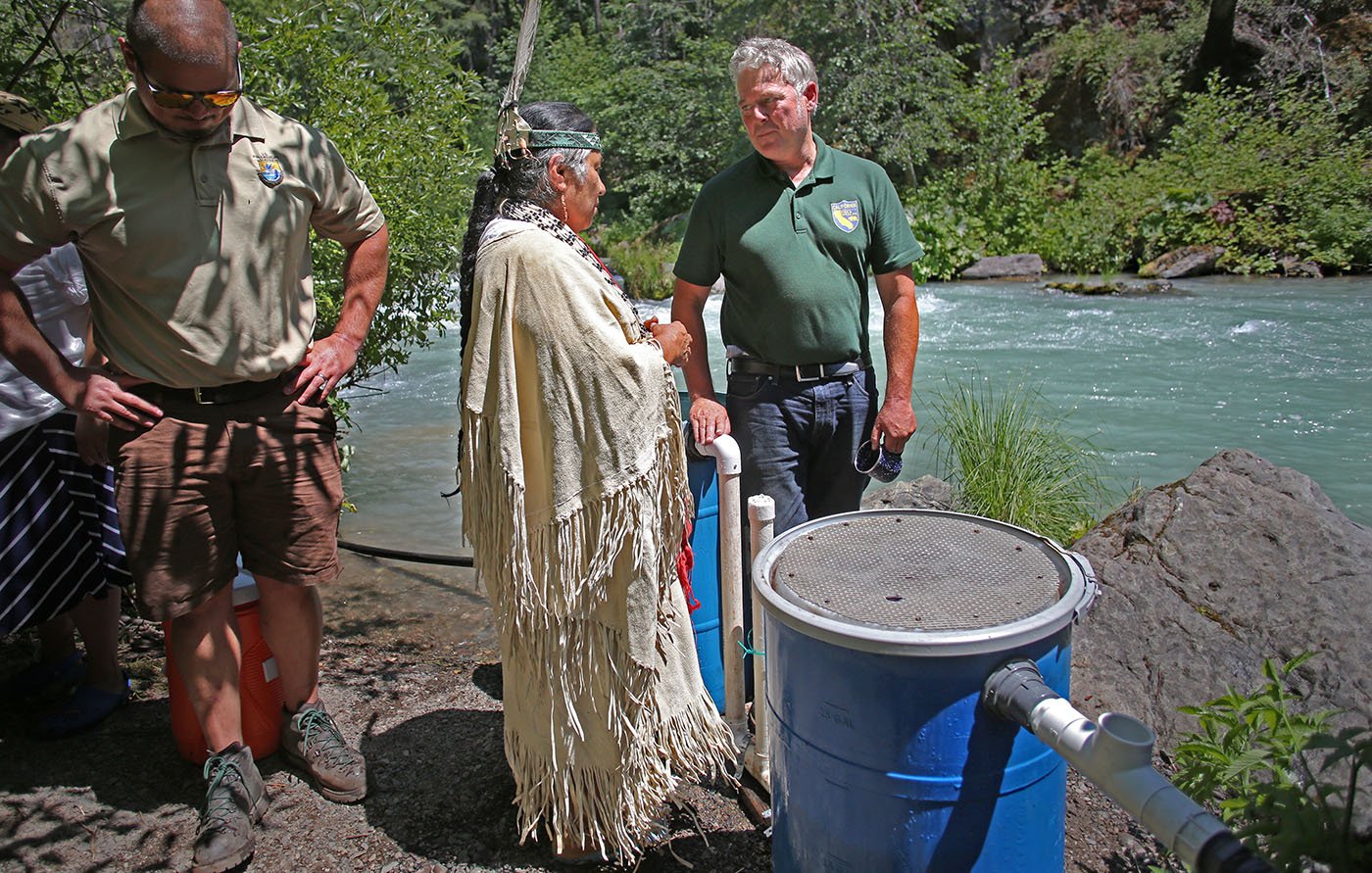
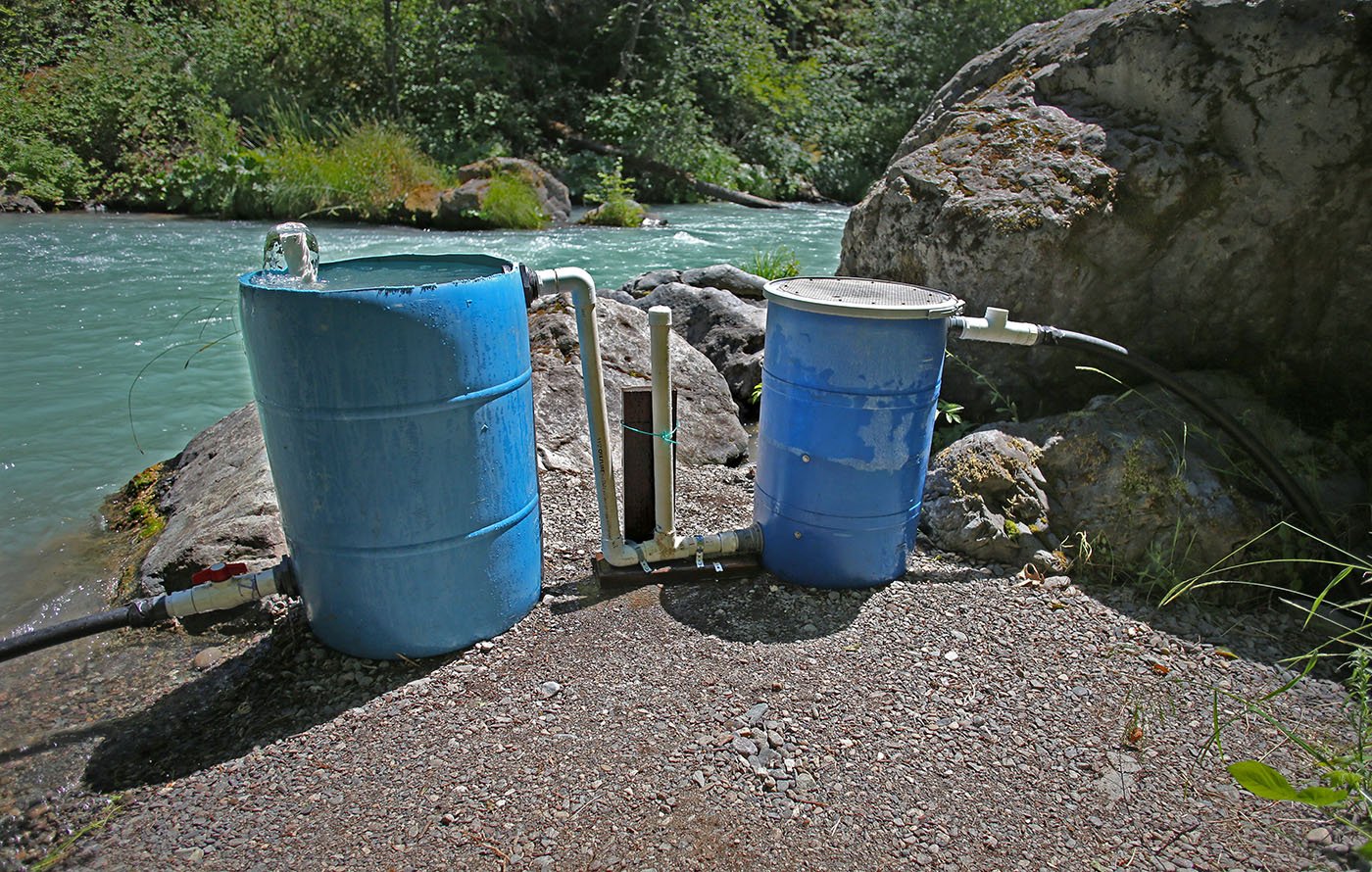
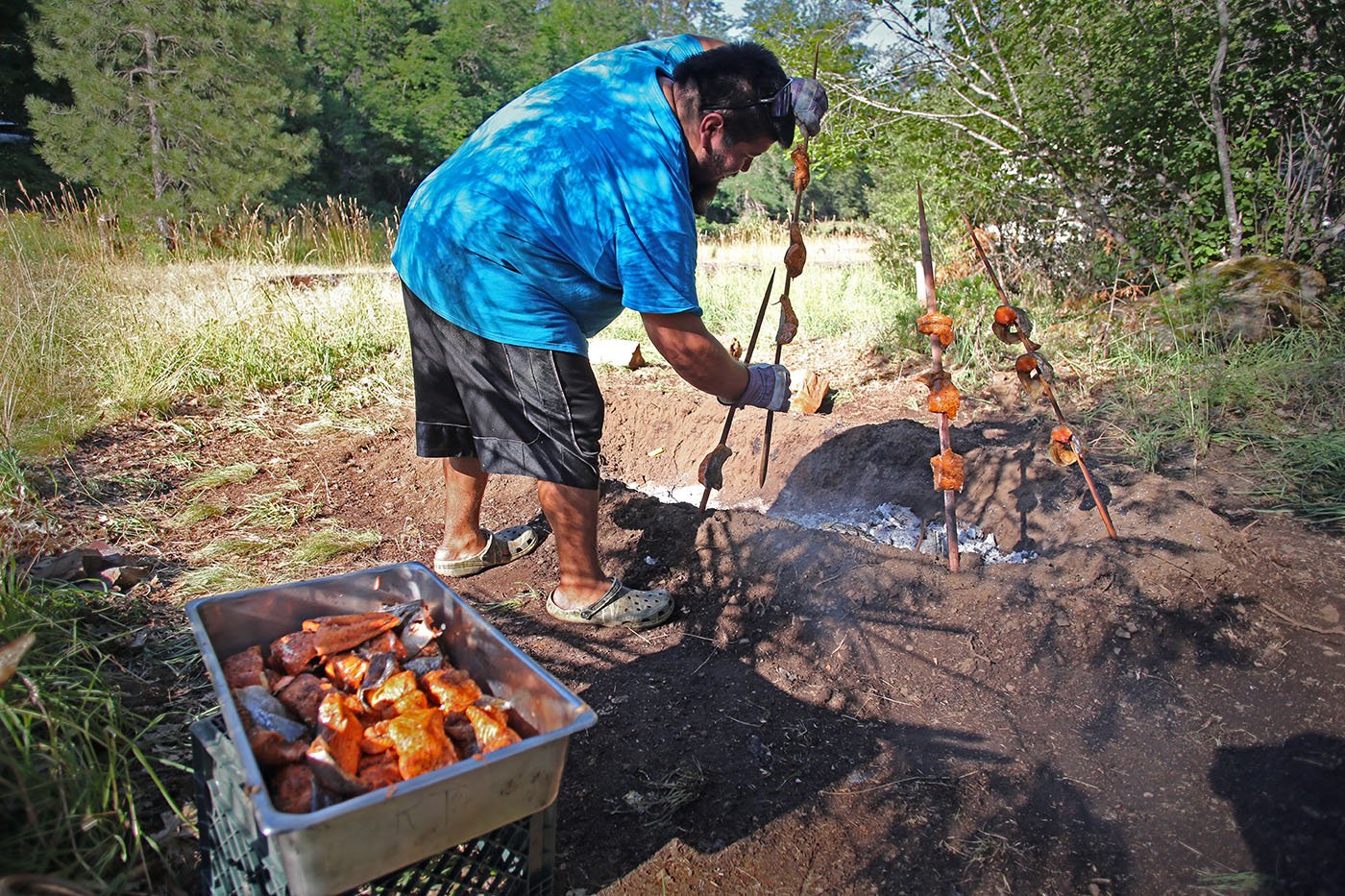
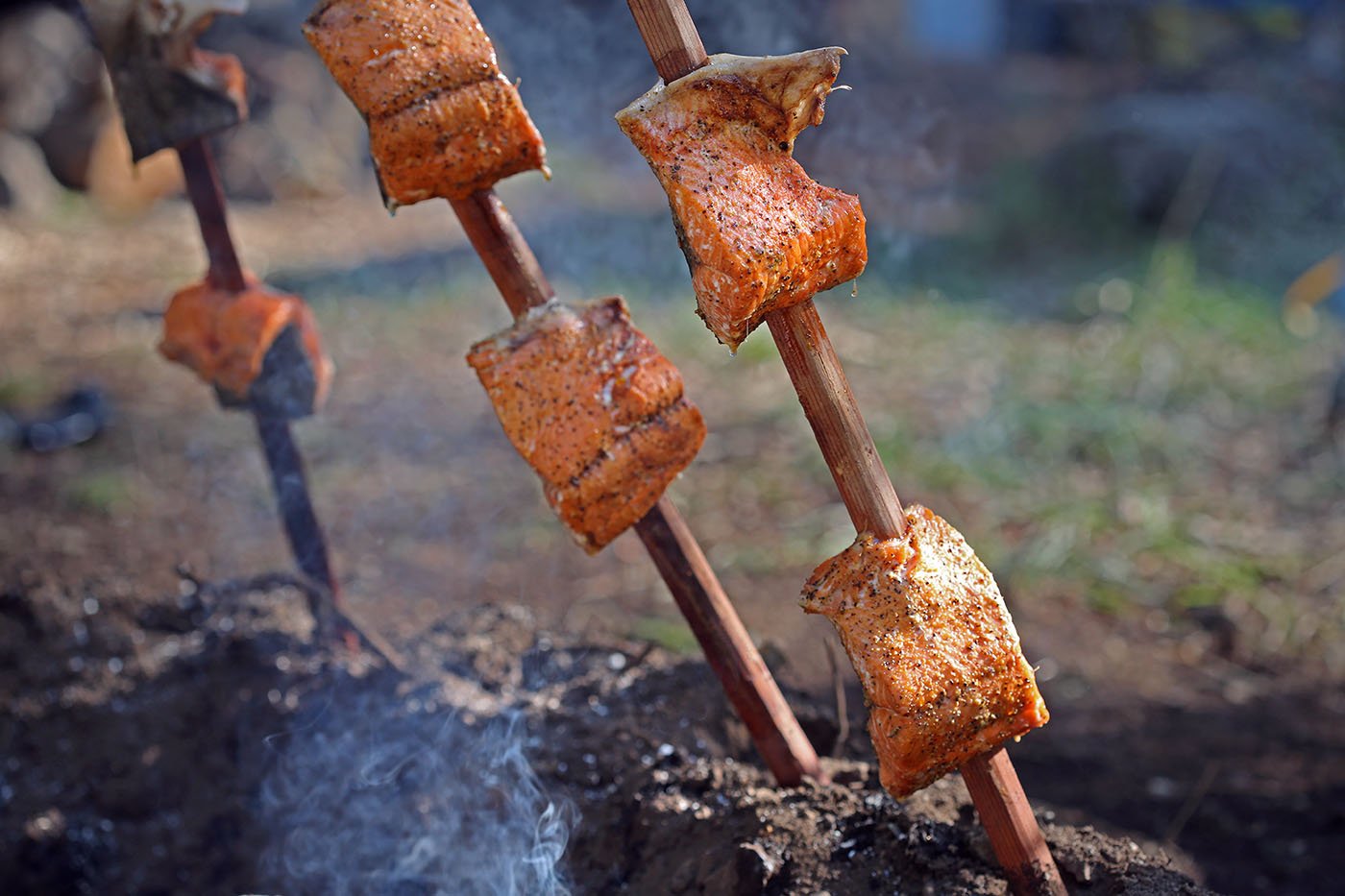
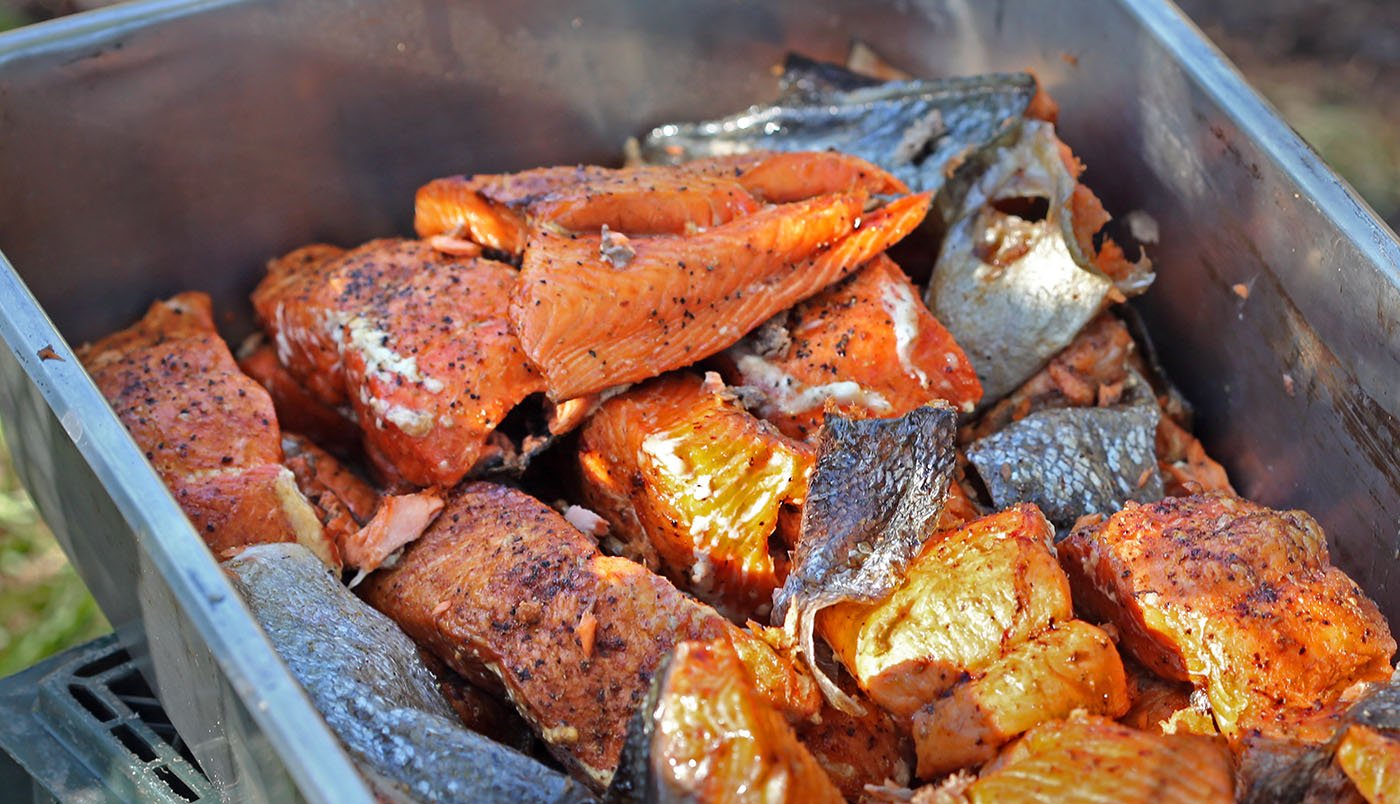
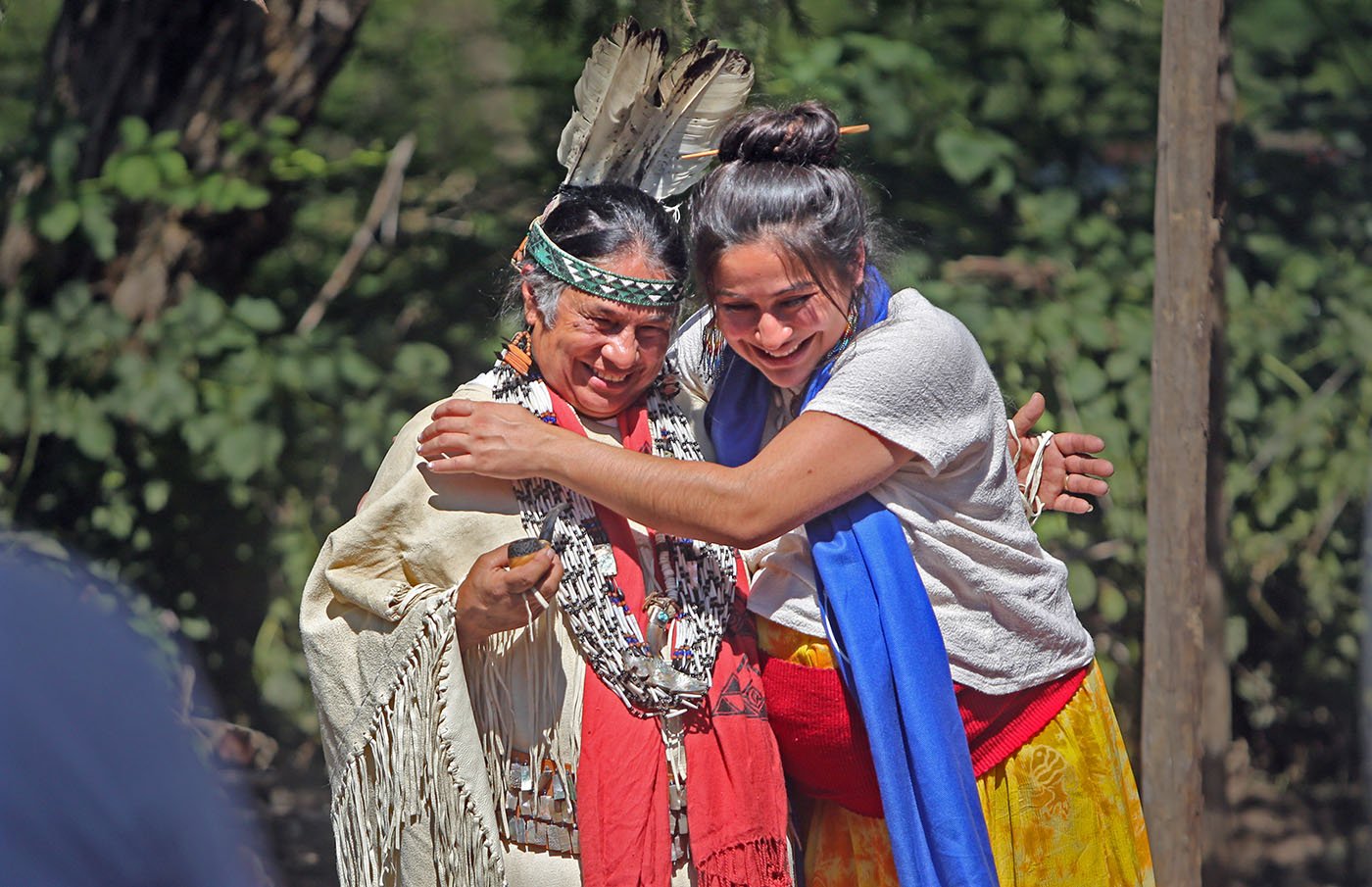
CHIEF SISK: Oh yeah. Mya, my granddaughter…We were riding home and she was sitting in the back seat right behind me. And I was talking on the phone. And the roadway here, from this point on, you lose signal. So I pulled over right here to finish my conversation.
MYA: Hello.
CHIEF SISK: And so she got out to come down to the stream.
It was 2021 and at the time, Mya was five years old.
CHIEF SISK: So she was at the stream and playing...
MYA: I see the water.
CHIEF SISK: Yeah, you see the water and then...
MYA: Salmon!
Mya yelled out, “salmon!”
CHIEF SISK: [Laughs.] And then you come running up to the car saying, ‘It’s Run4Salmon. Grandma, it’s Run4Salmon.’
MYA: Run4Salmon
The Run4Salmon is an annual 300-mile prayer journey the Winnemem Wintu started the year Mya was born. Its purpose is to call salmon back to these and other waters of this area. At first, Chief Caleen doubted Mya had really seen a salmon. No one had spotted one in this creek for decades.
CHIEF SISK: I didn’t know it was a salmon, but I was like, yeah, I’m hoping it is.
She got out of the car and walked down to the creek.
CHIEF SISK: And to come down and see that in fact it is a salmon.
Chief Sisk and Mya followed the fish for a little ways upstream. When they lost sight of the salmon, they came back to the bridge where Mya wanted to play.
CHIEF SISK: And so we were playing and she was in the water there and here they come downriver.
The salmon had turned around. Several had swum back to the bridge, to dig spawning nests in the middle of the creek.
CHIEF SISK: And she goes: ‘Sing, Grandma.’
Mya knew the protocol. Her grandmother should sing.
JUDY SILBER: Can you point to me where you saw the salmon?
MYA: Right there.
CHIEF SISK: Yup.
MYA: And right there.
These were fall-run Chinook salmon, named because they leave the ocean to migrate upriver in the fall. Of all the runs on the river, fall-run are the most abundant, but their numbers have decreased a lot since the 1800’s. And it’s gotten worse in the past few decades. Chief Sisk remembers her uncle used to catch the fish on the property where she now lives, the place they call “the village.”
CHIEF SISK: They used to swim up here all the time even to the village. My uncle would pitchfork them out from behind the village and cook them on the BBQ right there. But for decades, they’ve been gone.
To see them in the creek with Mya, and later to see them spawn, was proof of concept for Chief Sisk. That salmon could be restored, both here below Shasta Reservoir— and up above it on the McCloud, a river that the Winnemem Wintu have a special relationship with.
CHIEF SISK: So it was like a miracle, you know? A prayer that’s coming true.
CHIEF SISK: We’re singing these songs. We’re going along. Putting our paddles on the water to call those fish back.
CHIEF SISK: This is something that can actually happen. And those salmon already know it. I feel like they’re helping to explain this to the fish experts who think, well, they haven’t been there for 30 years, they’re not coming back. if we put those songs and prayers on the water. If we take that all the way to the ocean and we sing to the ocean and we dance to the ocean, they respond.
***
SILBERr: I’m here with Lyla June Johnston. She wrote an anthropology paper with the Winnemem Wintu during her time at Stanford. She’s also a musician.
SILBER: So Lyla, all of us think about the future. But there’s a big difference in the way most Americans think about the future versus indigenous people. The American ideal has to do with creating technological fixes for our problems. So we’re making electric cars. We’re thinking about colonizing Mars…
LYLA JUNE: Well, Elon Musk in his futuristic vision sees people on Mars. Chief Sisk in her futuristic vision sees salmon in the McCloud River Basin.
SILBER: And of course, there are no salmon there right now.
LYLA JUNE: No, they were blocked by Shasta Dam in the 1940s. And so, her futurism is not about escaping earth or doing something cool and fancy. In my opinion, it’s more about taking care of the earth that we have and restoring the vitality and the biodiversity of that life. So a lot of indigenous futurism is ecologically based. How do we ensure that these life systems will be available, not just to human descendents, but even to the children of bears, the children of eagles, the children of salmon. To us, they’re people, too. Even though they’re not people. And so, we really have our futurism tied up in our responsibility to take care of these things as they take care of us.
A lot of indigenous futurism is about protecting water. Is there going to be clean water for future generations? Is there going to be water at all? And so I think that these are just, like you said, different ways. That one is about zooming around in electric cars as a bandaid, really, for our obsession with mastering nature. And the other one is more about how do we protect these languages and cultures that teach our children to live humbly on the earth.
***
In the future envisioned by the Winnemem Wintu, salmon are once again thriving in Northern California. They want salmon spawning in the McCloud river where their ancestors lived, up above Shasta Dam where they have not been since the dam’s construction. Seeing salmon on the McCloud again is also a goal of the federal government though the Trump administration had mostly put reintroduction on hold. But by 2021, planning had picked up. And, for the Winnemem Wintu these conversations felt different. The government was requesting input in a more collaborative way. Chief Caleen told me she was attending a lot of Zoom meetings.
CHIEF SISK: We’re on a Zoom call and if it’s not with the State Water Board about the fish, it’s with NOAA and the U.S. Fisheries and California Fish and Game
With so many meetings, she’d lose track of what each one was about.
CHIEF SISK: And it’s like, it has one little piece, but it’s not that meeting. It’s like, okay, wait a minute.
SILBER: Wait, I’m confused. You’re saying, sometimes you don’t know who you’re talking to.
CHIEF SISK: You’re confused? [laughter] Yeah, sometimes it feels like oh, I need to say this to these guys because...and then they’ll say, oh, we’re not doing that project.
All of these government officials had one main goal. They wanted eggs from an endangered population, the winter-run salmon, in the McCloud River. The cold waters could help protect them from drought, which is coming more frequently and for longer periods in California. Their plan to deal with Shasta Dam was to truck juveniles around it. Chief Sisk had opinions about that.
CHIEF SISK: Our thing is that, we’re in favor of the truck and haul for at least a couple of years.
But after that, she wanted a natural passageway built. It would re-route the salmon around the dam by way of tributaries and creeks. Possibly a tunnel would also be needed for at least a short stretch. But the big idea was to let the fish swim — on their own — out to the ocean and back. This isn’t the focus of current government plans. So on those Zoom calls, Chief Sisk is always bringing it up. She also has a different idea about where to source salmon eggs for the McCloud.
CHIEF SISK: We are not in favor of using hatchery fish.
The government wants to use winter-run eggs from a hatchery. But the Winnemem Wintu…
CHIEF SISK: We are pushing for eyed eggs from New Zealand.
CHIEF SISK: These are the fish we want.
More than a century ago, eggs from the McCloud and other nearby creeks were shipped to New Zealand. Ever since, the fish have swum in that country’s cool, mountain waters. The Winnemem Wintu feel an affinity for the New Zealand fish. These are the salmon they want. But the U.S. government has resisted the idea. Instead, they prefer winter-run hatchery eggs because the winter-run are in trouble. In the spring of 2022, government officials were scared.
CATHY MARCINKEVAGE: This was kind of early on in the season, but it was the driest January, February, March we had had on record.
Cathy Marcinkevage is an administrator with the National Oceanic and Atmospheric Administration, or NOAA. California was in a drought.
MARCINKEVAGE: A couple of staff and I came out of some really depressing meetings where we saw those projections and said, we need to figure out what we can do.
Chinook salmon have a three-year life cycle. The drought had wiped out winter-run eggs for two years running. If it happened yet another year, that could be the end of the winter-run. The end of a salmon population not found anywhere else in the world. The agency realized it had to move fast. They decided to plant adult winter-run in the upper part of Battle Creek, a tributary of the Sacramento River.
MARCINKEVAGE: To put them into Battle Creek where there are cooler waters and that got fish into a part of that river that hadn’t been there for 100 years.
Then they thought about the McCloud River. Could they get fish up there? It would be a year earlier than planned. NOAA officials approached the Winnemem Wintu.
MARCINKEVAGE: We did start talking to the tribe, just to say, so you know, it’s a really bad year. We don’t want this run to go out on our watch. We’re doing what we can. We have these other actions. There’s one we maybe want to seize this opportunity to take. What do you think? And we started the conversations.
CHIEF SISK: A lot of things are problematic.
The government wasn’t going to move forward without Winnemem Wintu buy-in. But in May of 2022, Chief Caleen Sisk was still thinking. She weighed the pros and cons.
CHIEF SISK: Gas, getting there, our time, our knowledge.
These may sound trivial compared to a fish going extinct. But the Winnemem Wintu haven’t forgotten the mistreatment and broken promises of the past two centuries. They resent being called on to contribute time and money without much compensation.
CHIEF SISK: And they’re using fish that they absolutely know that we have been objecting to.
CHIEF SISK: They want to save the winter run. They want to do that. They want us to work for free, to get it done. Because we can’t possibly let the winter run die off after all of these years of killing them every year. It’s like it’s our emergency now to save the salmon.
She’s right. The winter-run population has teetered for a long time – most of it due to government policies. Dan Bacher is a journalist who keeps a close watch on the fish. He thinks about where they used to swim before Shasta Dam.
DAN BACHER: See these fish went up into the tributaries of the Sacramento, the McCloud River, the upper Sacramento River, the Pit River, to spawn. And they went way up into the higher elevations. They ascended waterfalls to spawn in the mountains. They developed that over many, many millions of years.
After Shasta Dam’s construction, winter-run numbers went down. But they still maintained a healthy population.
BACHER: Even after the dam was built, there was 117,000 fish.
But then the federal government built another dam—the Red Bluff Diversion Dam. Below Shasta, it further restricted how far the winter-run could migrate. It devastated the population. In 1989, winter-run made the endangered species list.
BACHER: And then it went down, plummeted to a low of just 200 fish in 1992.
The government took precautions. It built the winter-run hatchery. Eventually took the Red Bluff dam offline. They also got more careful with Shasta Dam cold water releases so the winter-run would have better temperatures for spawning. It restricted commercial fishing in the ocean. But winter-run numbers have stayed low. Fishery officials feared any calamity on the Sacramento River would wipe them out. Then drought arrived and forced the issue.
NOAA officials wanted to fast forward the re-introduction of Chinook salmon on the McCloud River.
CHIEF SISK: Tell me about what’s going to happen.
In the end, the Winnemem Wintu agreed.
MATT JOHNSON: So we did our flow test here and…
They would help, and do their best to ensure the plan’s success. In exchange, Chief Caleen wanted a promise from the government: That within a few years, the New Zealand salmon would be here.
JOHNSON: How do you feel about this spot here?
Chief Caleen Sisk and Matt Johnson, an environmental scientist with the California Fish and Wildlife Service, stand on a small gravel beach next to the noisy waters of the McCloud. If Chief Caleen agrees to this spot, winter-run salmon eggs could be hatching here for the first time in about 80 years.
CHIEF SISK: And so, I wanted you to get smoked off.
Chief Caleen tells Matt Johnson they’ll do a cleansing ritual, smudge him off with the smoke of a lit root.
CHIEF SISK: …that are going to try and take care of what we call the nur, or the salmon. They used to be here a long time ago. They’re not here now. We and the river want them back.
He removes his cap. He stands with arms slightly outstretched, palms facing the river, eyes closed as a tribal member waves the smoke around. He tells me later, he had no idea any kind of ceremony would happen.
JOHNSON: I did not dress for it. I’m in flip-flops and shorts. It was...I don’t have a tradition in a church or anything. So I’m, I haven’t had a lot of experience with ceremony. The best I could say is I felt something from the experience. It was an honor to be a part of it.
Matt Johnson tells me for the past 20 years he’s worked with salmon on the tributaries of the Sacramento River. And over that time, he’s watched the fish decline. He says this area could still support robust salmon populations, but California would need to rethink how it manages its rivers.
JOHNSON: Our water management in the last 20, 30 years is such that salmon are barely hanging on.
Nature used to command the river. Now it’s humans. Normally in the fall and winter months, water would gush down the Sacramento River with the rains. Migrating salmon evolved to use those conditions. But over time, more and more water has been saved and diverted for cities and farms. And now, because of climate change, California has less to go around. Salmon populations are suffering.
JOHNSON: They’re relying on those few wet winters or wet cycles we get. And we see a response from salmon in those years. And then we get right back into drought conditions,
Chief Sisk is well aware of the perilous situation for salmon. But in this moment, she’s hopeful.
CHIEF SISK: When I was praying and stuff, I could feel like my Grams, my great-grandma Chipoki would be growing up in this village as a little girl.
Chief Caleen’s great-grandmother was born at a Winnemem Wintu village here in about 1871. Twenty-five years later, The village site passed into the hands of a wealthy San Francisco family, as did other land along much of the McCloud River. Eventually, the National Forest Service acquired this property and turned it into a campground.
CHIEF SISK: Grams was a little girl down at the Rock House, but she would have traveled to this village because her grandparents would be here.
Chief Sisk: Coming back and forth was happening all the time. So all of those people would be with the power of this river.
Even though Chief Sisk would have preferred salmon eggs from New Zealand she still gets emotional imagining any salmon swimming in the river. She thinks about the young Winnemem Wintu.
CHIEF SISK: Maybe we have that chance now to make it happen again so that Mya could see that, or Star or Rose or Lilly, all of the little ones.
To see salmon again on the McCloud…
CHIEF SISK: And give them that strength to be good people. Because that’s what I feel like they’ll bring is goodness. They’ll bring the goodness back.
SILBER: Can you believe that this is happening?
CHIEF SISK Well, I am skeptical [she laughs].
Two weeks later, we’re back at the same place. This time the campground is full, with Winnemem Wintu, supporters, and biologists from state and federal agencies. All here to see salmon eggs go in the McCloud. Sweating in the hot sun, Jamie Ward and other Winnemem Wintu men construct a circular ceremonial structure called an arbor.
JAMIE WARD: Well, right now it’s just a skeleton of what it will look like. It’s just our poles that are upright and then our strengthening horizontal poles that we’re connecting.
When it’s done, they’ll light a sacred fire in the center and cover an outer ring of posts with Douglas fir boughs.
WARD: Not for only shade, but just the overall presence of what we’re doing here, which is we’re going to dance here for hopefully the beginning journey of our salmon.
In just a few hours, winter-run salmon eggs will be placed in incubation barrels down at the river.
WARD: That’s why it’s important for us to lay down a very good ceremony here. Lay down our prayers here.
David Martinez is an elder in the tribe. He stands watching, off to the side.
DAVID MARTINEZ: We’ve got pictures of my grandfather holding salmon, he was six foot tall, salmon chest high and their tails touching the ground. That he pulled out of the McCloud River.
MARTINEZ: Oh, it’s...I want to see the salmon. I want to see it work. I want to bring my relatives home. It’s for all of humanity and it’s all for the earth. Every living critter. Every tree. Every bush. And for the water. We got to bring them home. Yeah.
The excitement felt by the Winnemem Wintu is in part fed by a co-management agreement the government is preparing. It details a multi-million dollar budget that includes paying for Winnemem Wintu time, studies for a natural passageway around Shasta Dam, and pathogen testing for the New Zealand salmon so they can be brought here. It’s a big deal. Jason Roberts, works for the State of California as a tribal liaison.
JASON ROBERTS: I think that’s...we had always been working with the Winnemem Wintu tribe, but it wasn’t always in a co-management full participation level like it is now.
Before Chief Sisk tried hard to get onto a committee in charge of exploring reintroduction. But the federal government wouldn’t allow it because the Winnemem Wintu are not federally recognized.
ROBERTS: I don’t think you’re going to find any specific policy paper. There’s been a pretty apparent shift at the state and federal level to seek out co-management… and bring in the tribes as full participants in a lot of different projects.
Still, Chief Caleen doesn’t fully trust it. And already, she feels slighted. Without her input, agency officials decided to drive, instead of helicopter salmon eggs here.
CHIEF SISK: I mean, we’re not bringing the eggs from New Zealand, flying them halfway around the world to bounce down this road.
UNIDENTIFIED NOAA OFFICIAL: You put it that way, it’s like, yeah, good argument.
The road to get here is unpaved, bumpy and steep. Only accessible by four-wheel drive. And a little scary. Chief Sisk is upset. She complains to a few government officials when they meet in the middle of a path that circles the campground. She’s afraid this sets a precedent for later.
CHIEF SISK: Your science says it’s going to be fine. Our spirituality doesn’t allow that. Because your science has not produced enough fish coming back.
Government scientists argue the eggs are at a particularly hardy stage, when they can withstand a lot. Chief Sisk doesn’t buy it.
CHIEF SISK: We’re not trying to stop the project, or not trying to make it difficult. But we do have an obligation and a privilege to these fish.
MARCINKEVAGE: But I appreciate you working with us on this.
CHIEF SISK: Yeah.
CHIEF SISK: What time do you think the eggs will get here?
UNIDENTIFIED NOAA OFFICIAL: So we think that they’re on the road now. So we are probably about an hour and a half out.
When the winter-run eggs arrive, it’s almost anti-climactic. Taylor Lipscomb from the Livingston Stone National Fish Hatchery helps pull a small orange Home Depot cooler from the back of an SUV.
TAYLOR LIPSCOMB: So this is a five-gallon cylindrical cooler with 20,000 winter run eggs in it. In water.
It could be filled with lemonade. Somehow I expected more. Early this morning, a small crew at the hatchery counted the eggs out by hand. The eggs are 30 days old and will hatch in about two weeks. Near the arbor, the cooler at their feet, Chief Caleen and Taylor Lipscomb talk logistics.
CHIEF SISK: we’re going to sing the warrior song. The Hup’chonas, for the eggs, the landata nur. We’re asking these eggs to become…Landata nur means old-time salmon. That they remember to be these old-time salmon in this water. Because they haven’t been there for 80 years.
As everyone watches, Chief Sisk’s daughter and niece pick up the cooler, step into the center of the arbor and circle clockwise around the sacred fire.
CHIEF SISK: The intent was to have the sacred bless those eggs…
This is the first sacred fire the Winnemem Wintu have had at this village site, likely in over 100 years.
CHIEF SISK: And so it was an important thing for us to bring them in. It’s like, our belief is whatever happens to the salmon happens to us.
The young women navigate the steep, narrow trail down to the river. Behind them follow a few Winnemem Wintu children, Chief Sisk and Taylor Lipscomb, the fisheries biologist who brought the eggs. He helps the children scoop the eggs into a camping cup and then empty them into an incubation barrel.
From about 200 feet away, a tube carries the river’s cold water into a barrel, where the sediment can settle out. The clarified water then flows into a second barrel where the eggs will hatch. Once that happens, the baby salmon with the yolk sac still attached, will sink down to another tray that’s full of gravel. Here, they’ll stay and absorb the yolk until finally, they’re ready to swim out into the river.
CHIEF SISK: I would like to ask the agency people to come up.
In a ceremony that follows, Chief Caleen calls the ten federal and state agency people here into the center of the arbor.
CHIEF SISK: We would like to take you around the fire. We would like to smoke you off. Maybe after this you’ll see things in a different way. Maybe you’ll feel things in a different way.
In front of the sacred fire, she invites each one of them to speak. It’s emotional. These are people who work with salmon all the time.
UNIDENTIFIED FISHERIES BIOLOGIST: Personally, my colleague and I, we work a lot on salmon below Shasta Dam and the past decade has just been bad news after bad news. It’s just been monitoring the demise of salmon and this is one of the few moments that’s soul-nourishing and inspiring and motivating. So it’s good.
There’s a lot of hope at this ceremony. A lot of imagining what could be. But Chief Caleen knows this is not a fairy tale ending. The work is not done. She turns 70 in a few months. She’s tired and she wants fish in the river, and in her lifetime. She wants to know that she’s set salmon, and the Winnemem Wintu on a good path.
CHIEF SISK: We’re showing the traditions of the salmon coming back…
CHIEF SISK: You see these little people in regalia. They're five years old, they have a long way to go with the salmon. And it's going to continue. So you need to deal with us.
That’s her message to the government. That the Winnemem Wintu’s connection to the McCloud and salmon is only going to grow. For the first time in her lifetime, young Winnemem Wintu are seeing salmon eggs on their own river with their own eyes. Chief Sisk says if the salmon can come back, maybe the tribe can bounce back as well.
***
A Prayer for Salmon is a project of The Spiritual Edge at KALW Public Radio. Support comes from the Templeton Religion Trust, California Humanities, the Kalliopeia Foundation, Save Our Spirits and The Water Desk, an independent journalism initiative of the University of Colorado Boulder. We are produced on Ohlone and Coastal Miwok land.
Thank you to the Winnemem Wintu and the Run4Salmon community for welcoming us, our microphones and cameras into their midst. To contribute to the Winnemem Wintu’s nonprofit, go to sawalmem.io.

